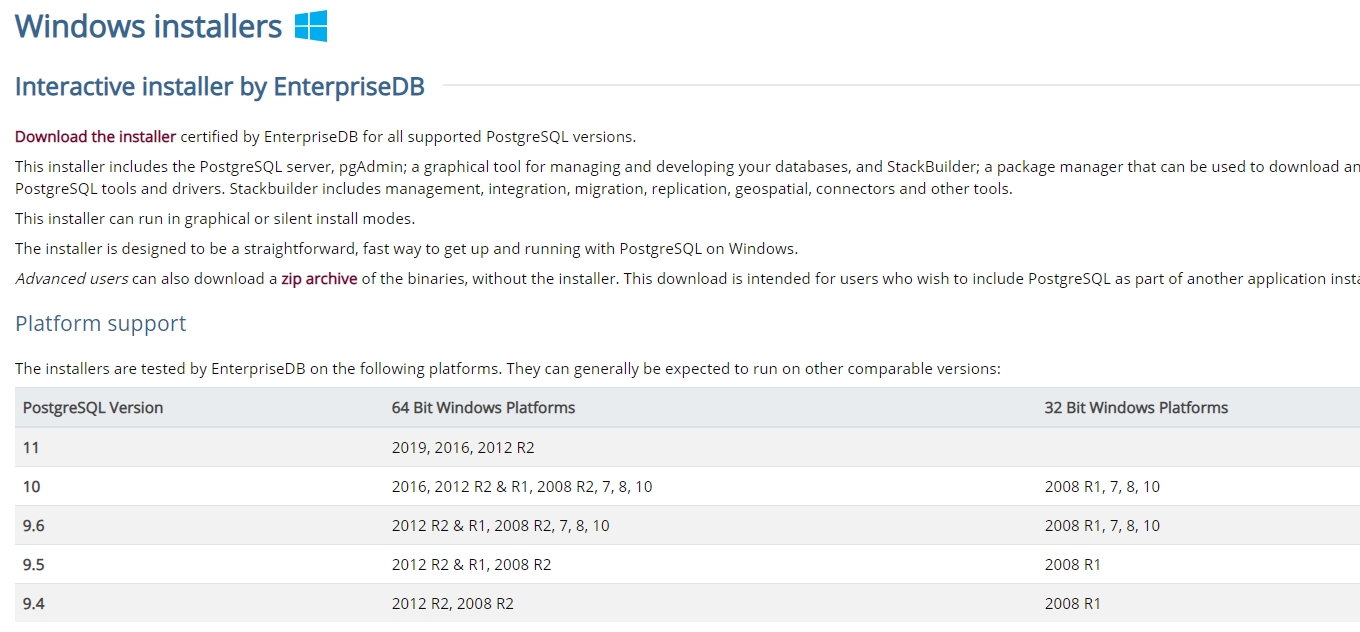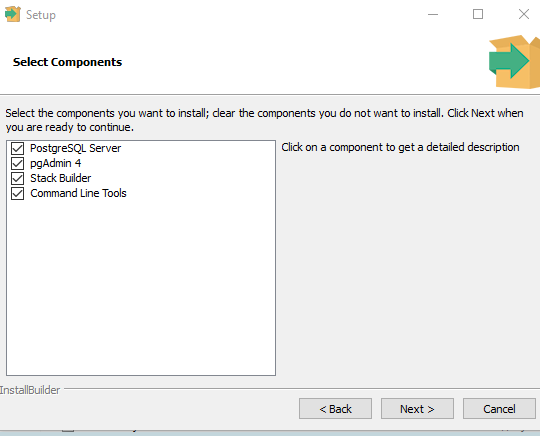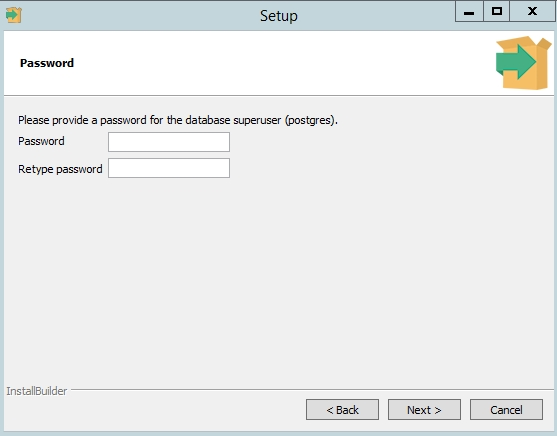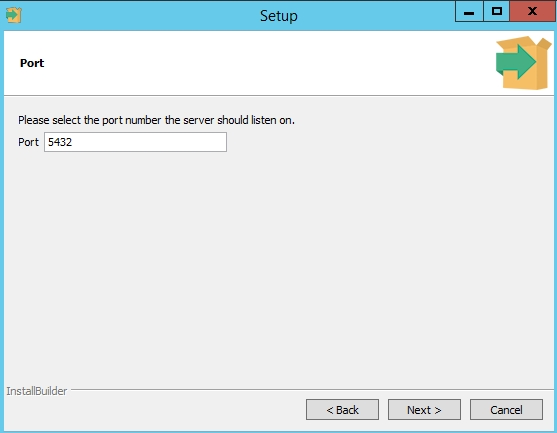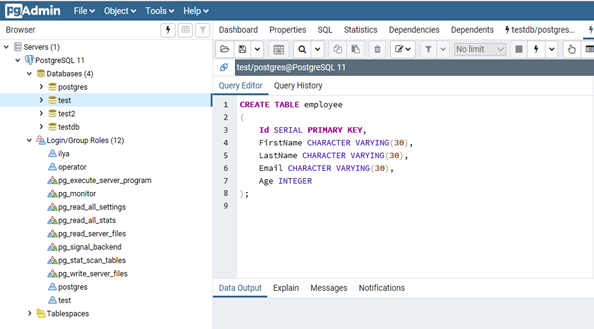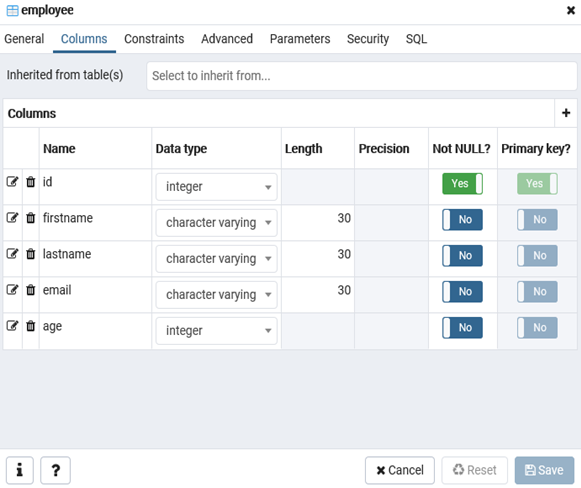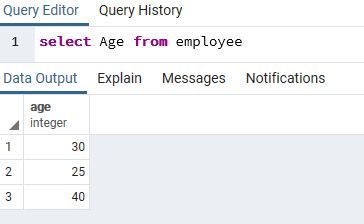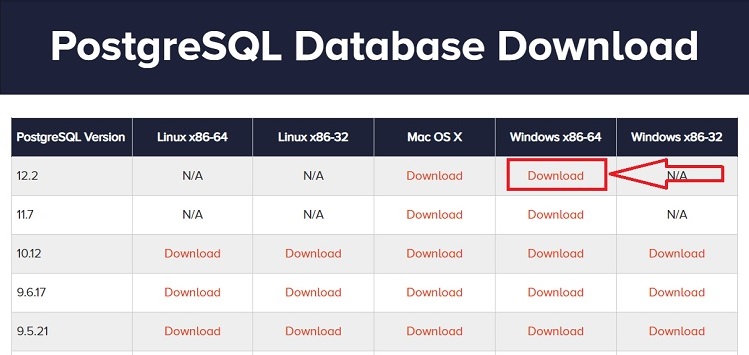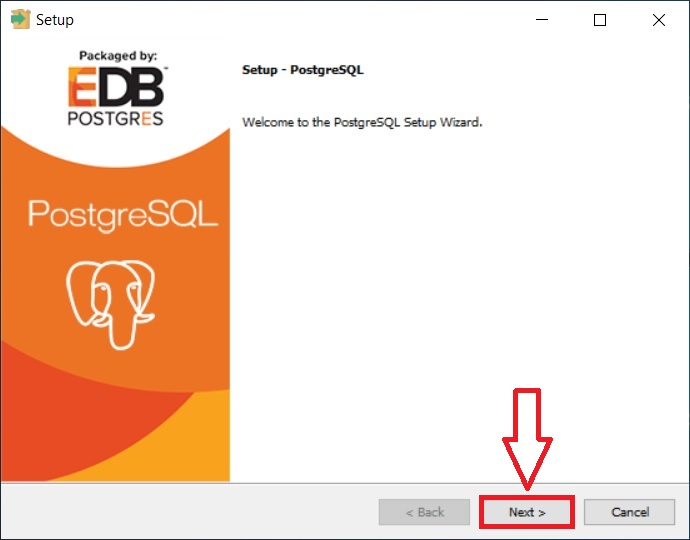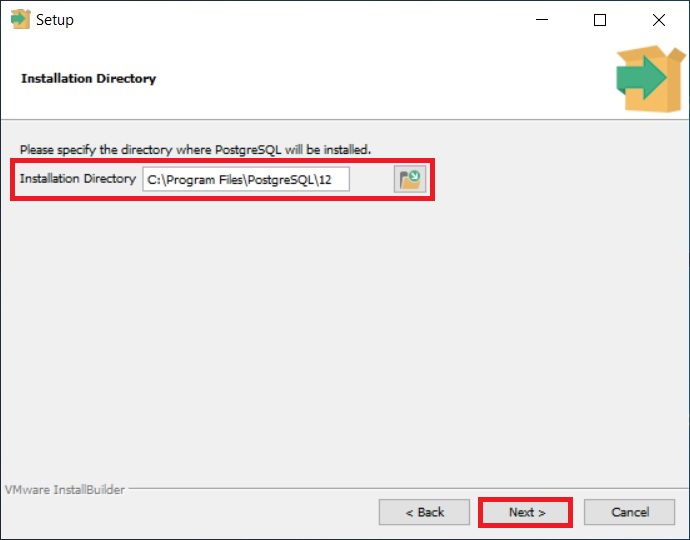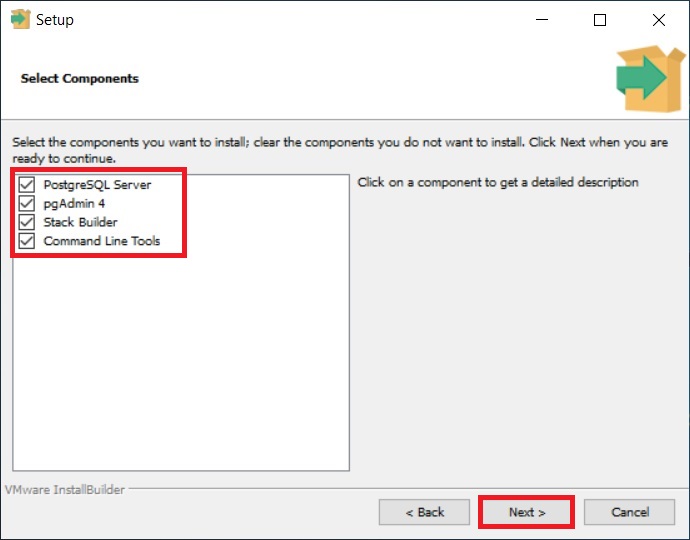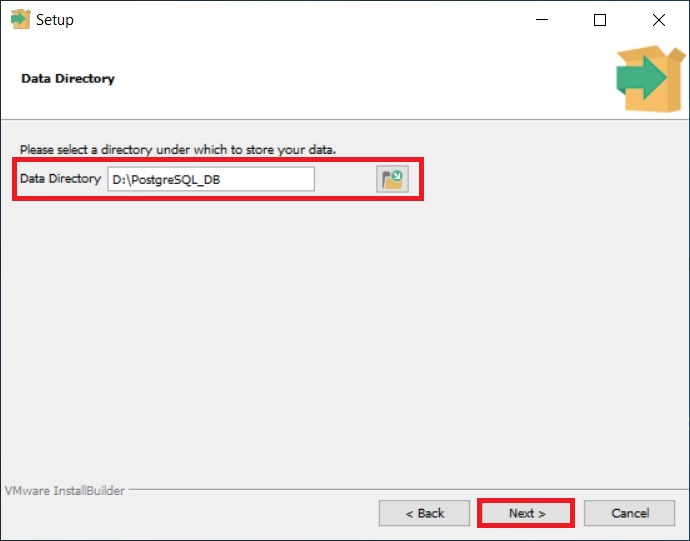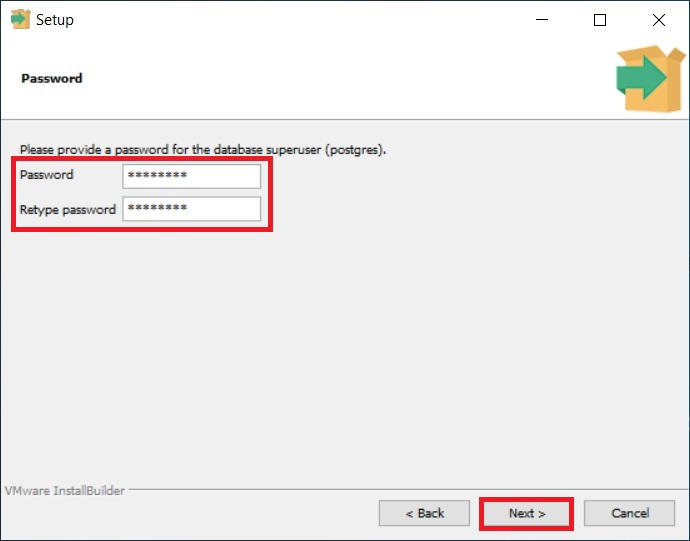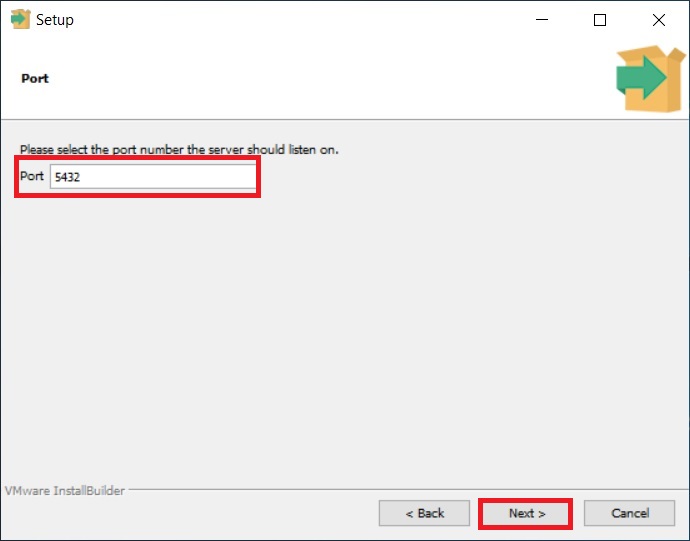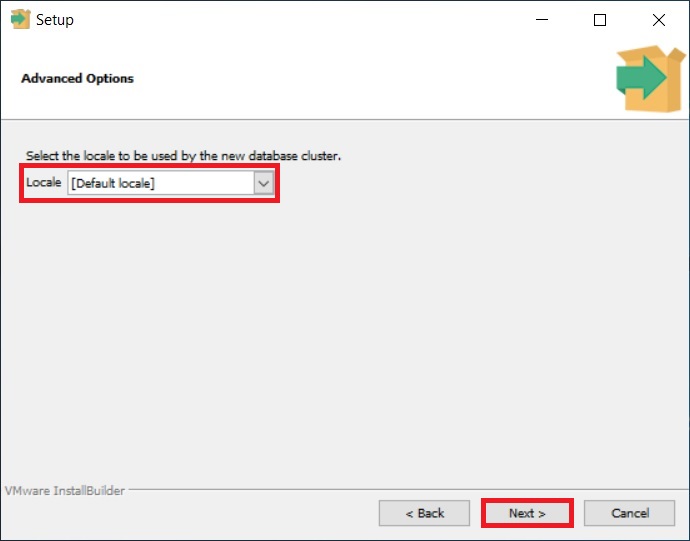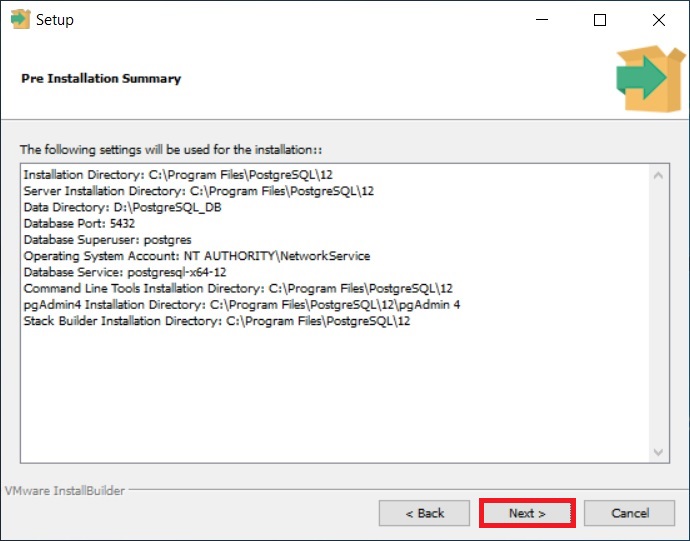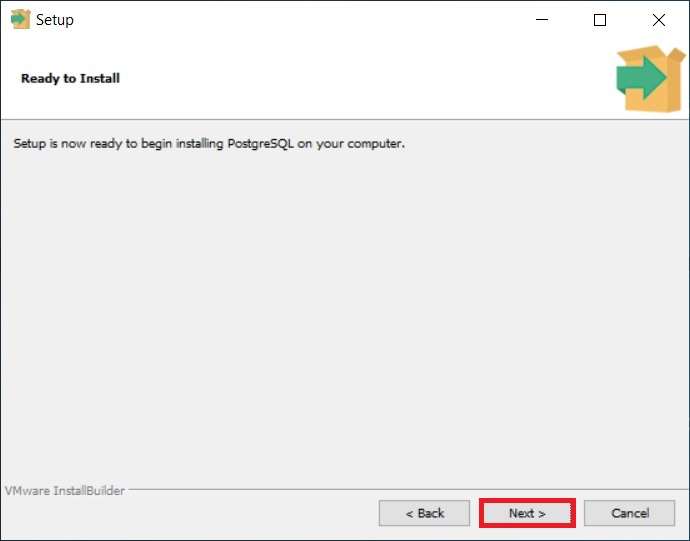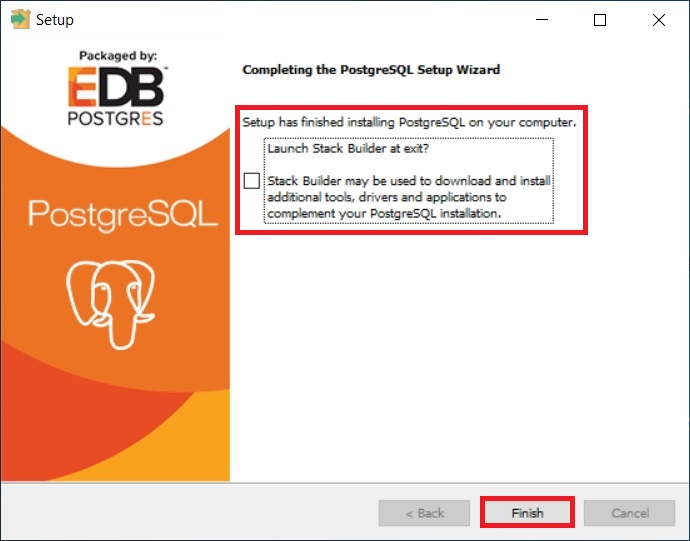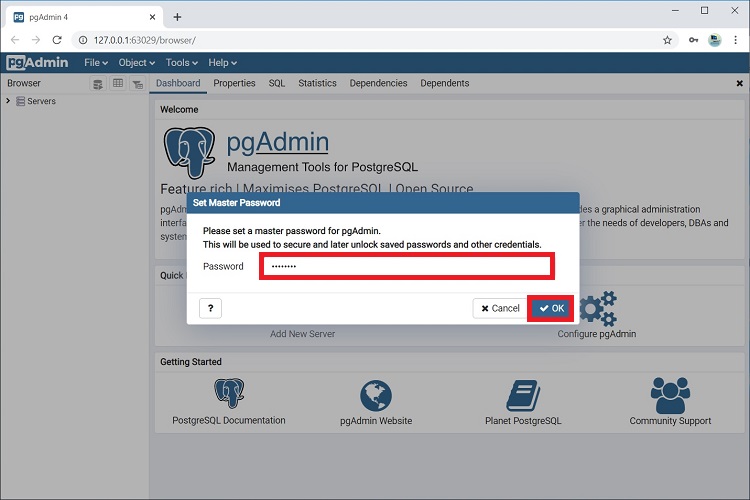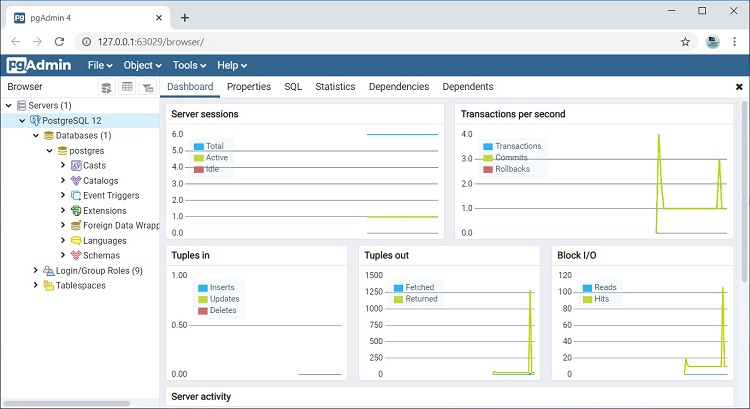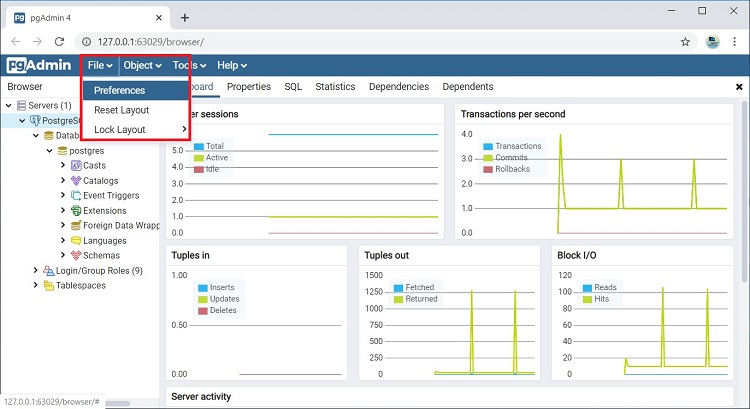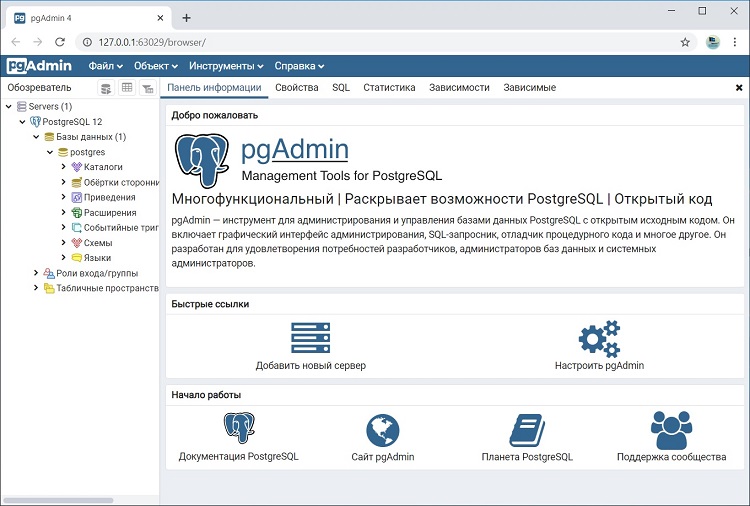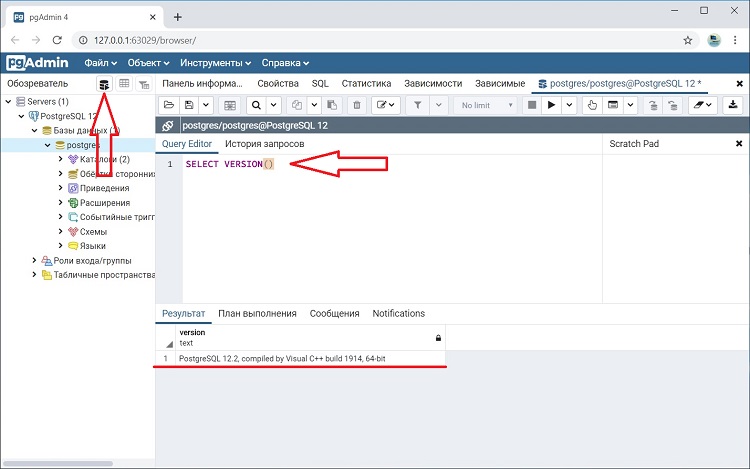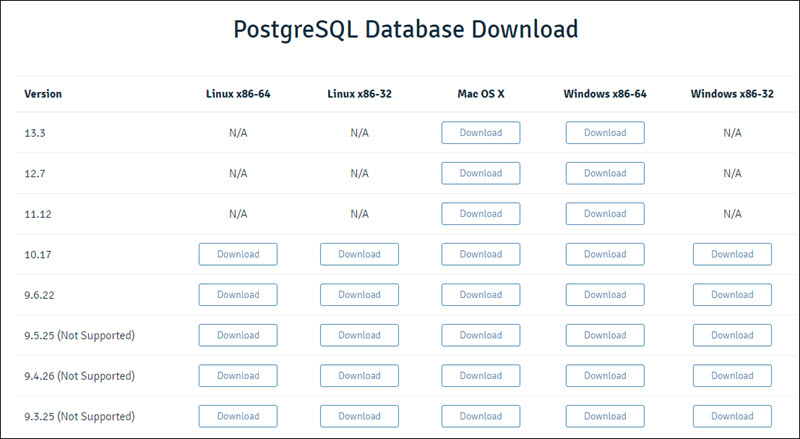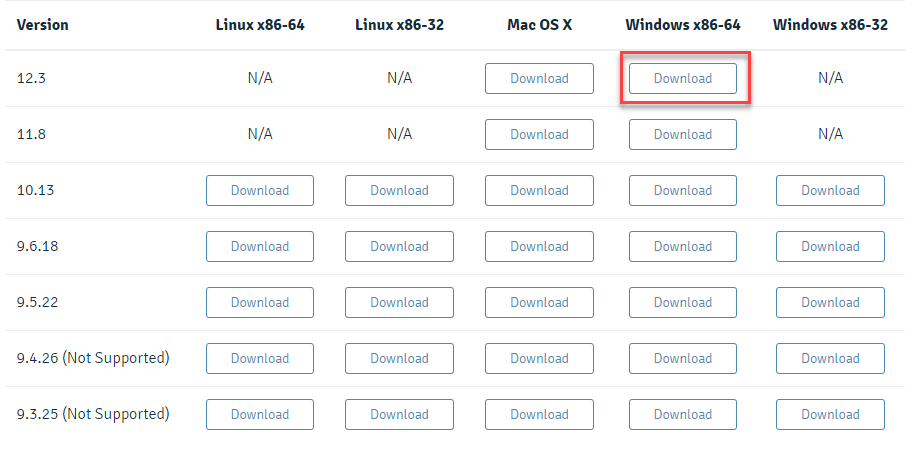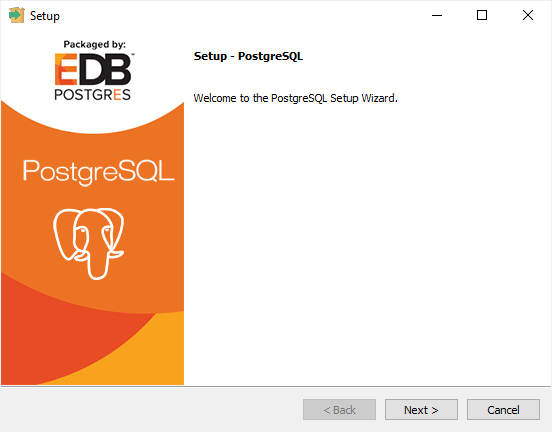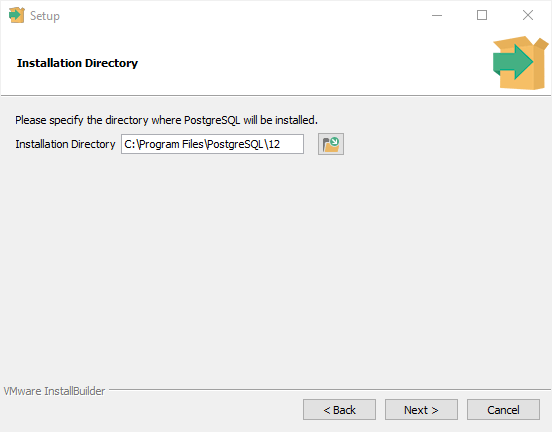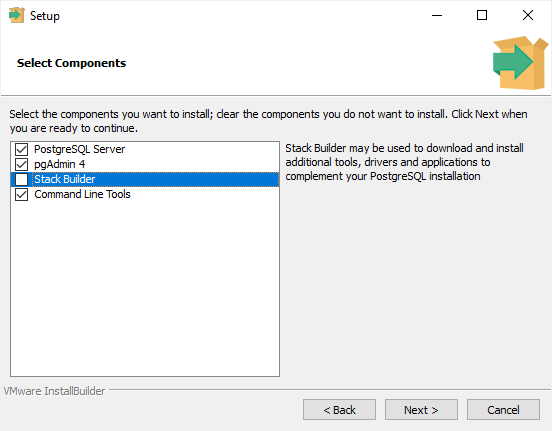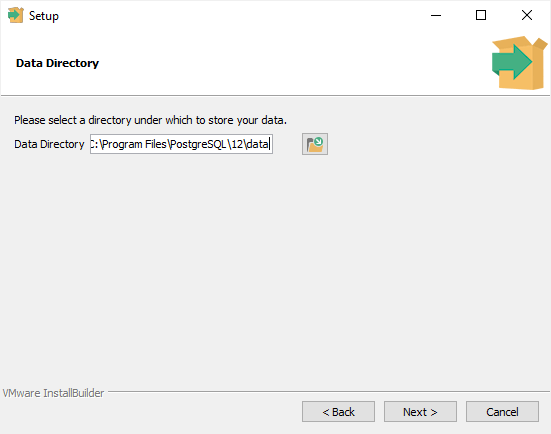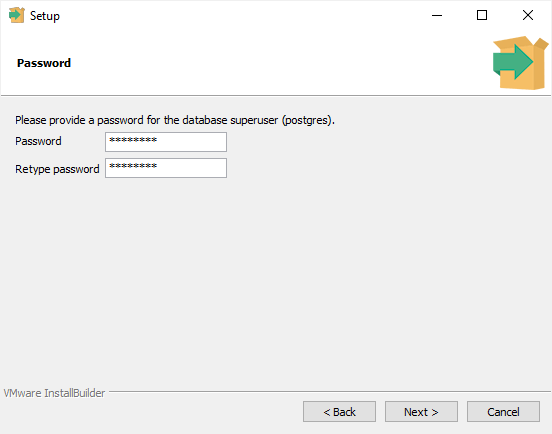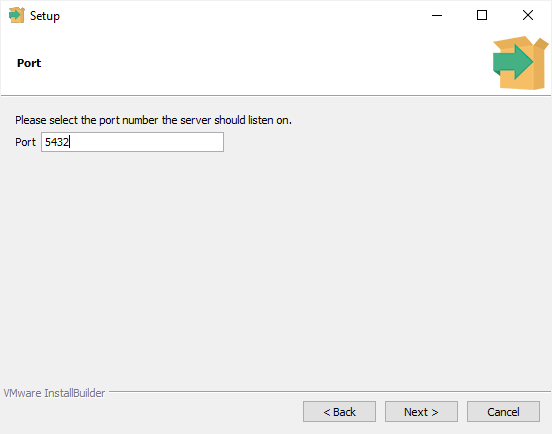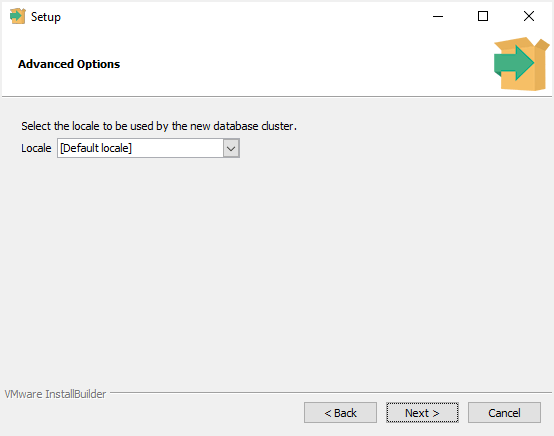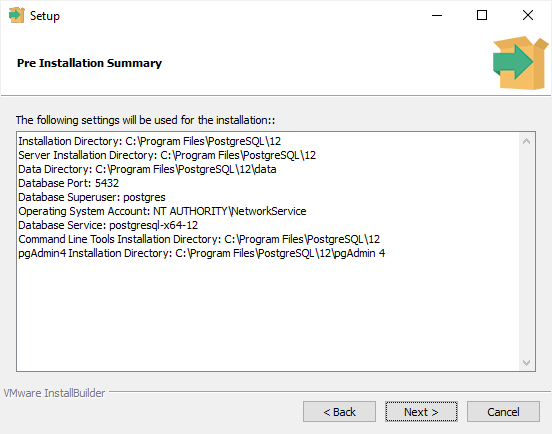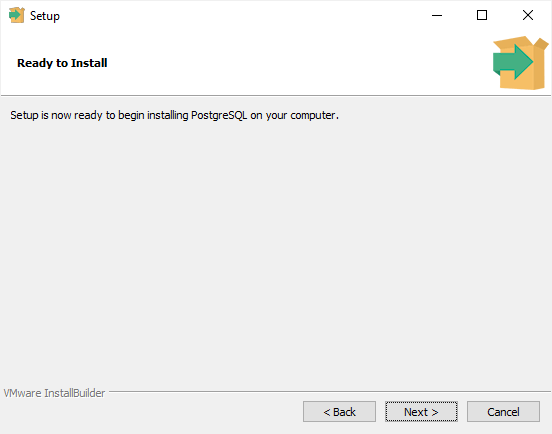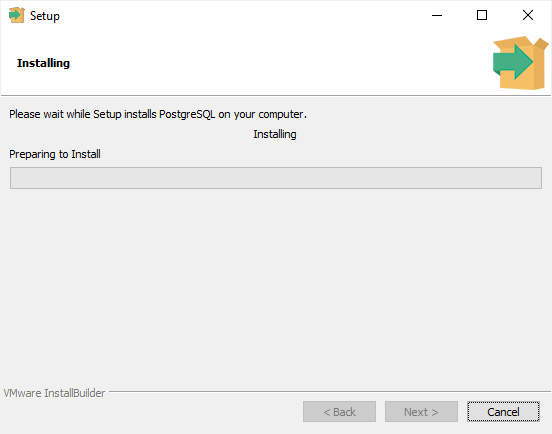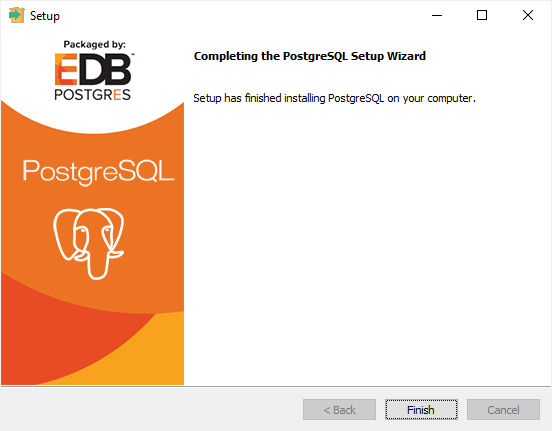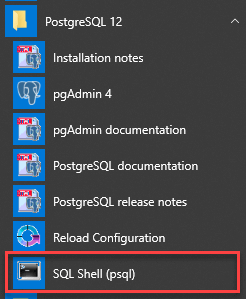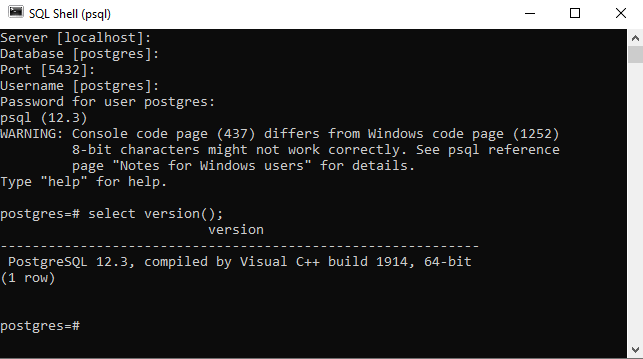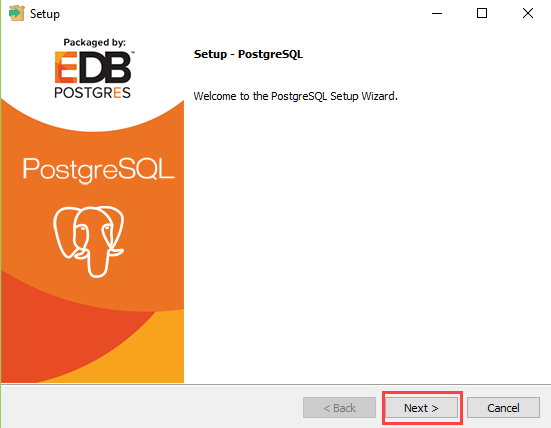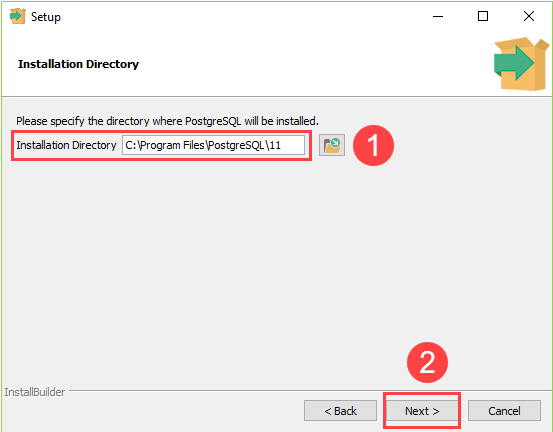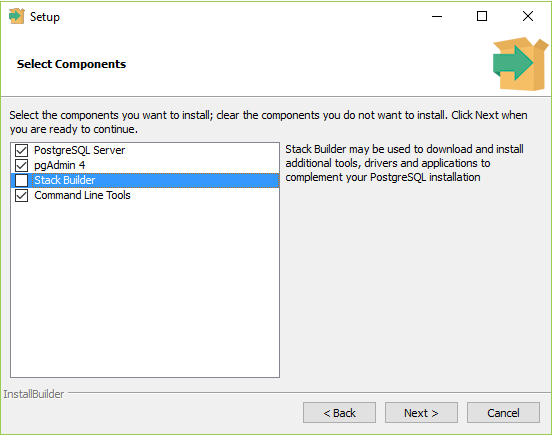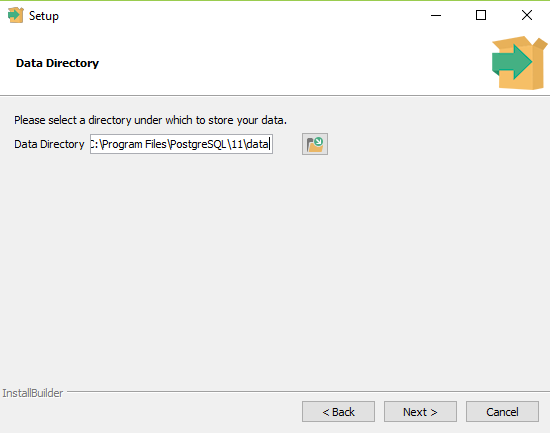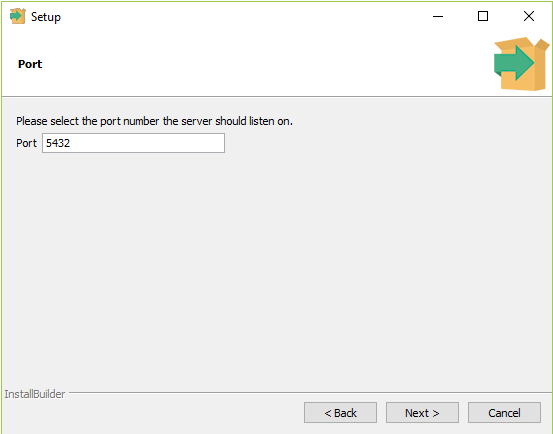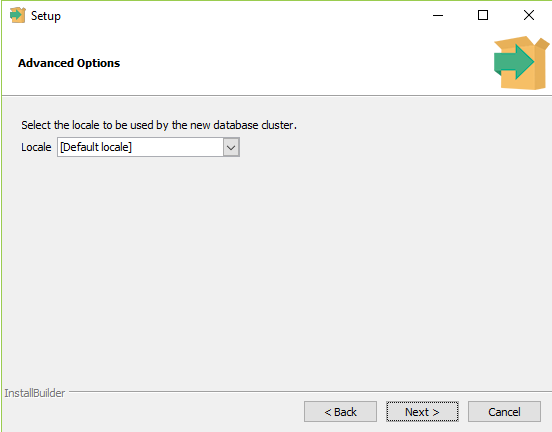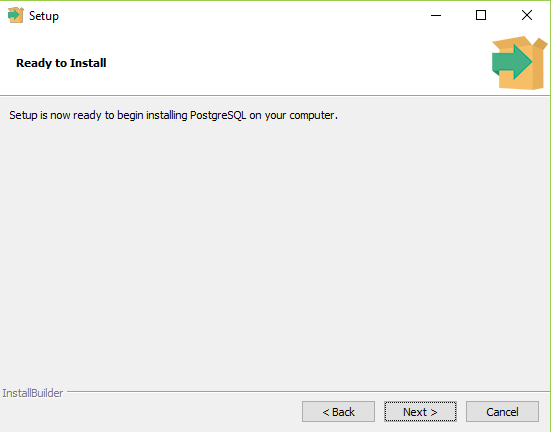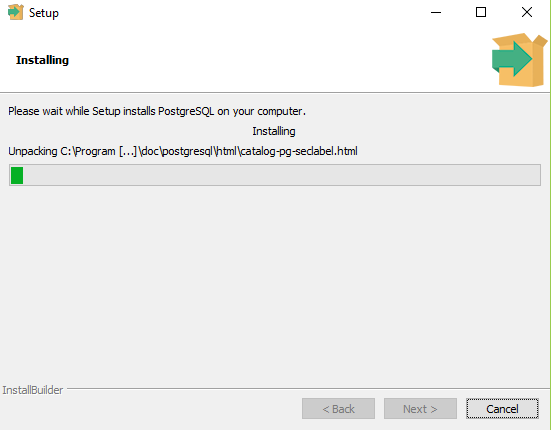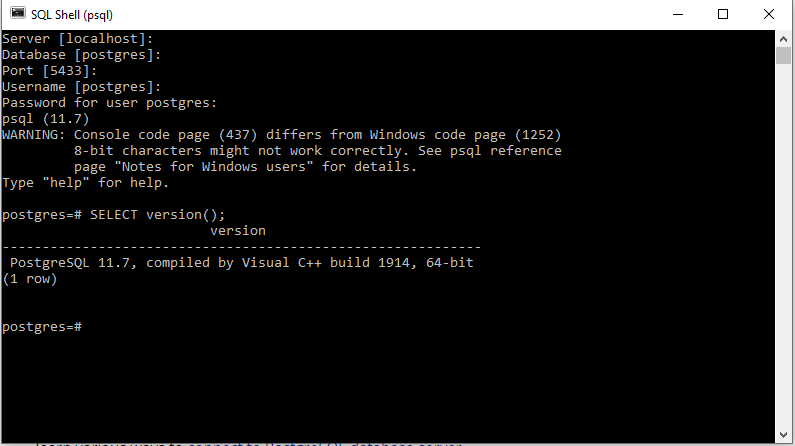PostgreSQL — это бесплатная объектно-реляционная СУБД с мощным функционалом, который позволяет конкурировать с платными базами данных, такими как Microsoft SQL, Oracle. PostgreSQL поддерживает пользовательские данные, функции, операции, домены и индексы. В данной статье мы рассмотрим установку и краткий обзор по управлению базой данных PostgreSQL. Мы установим СУБД PostgreSQL в Windows 10, создадим новую базу, добавим в неё таблицы и настроим доступа для пользователей. Также мы рассмотрим основы управления PostgreSQL с помощью SQL shell и визуальной системы управления PgAdmin. Надеюсь эта статья станет хорошей отправной точкой для обучения работы с PostgreSQL и использованию ее в разработке и тестовых проектах.
Содержание:
- Установка PostgreSQL 11 в Windows 10
- Доступ к PostgreSQL по сети, правила файерволла
- Утилиты управления PostgreSQL через командную строку
- PgAdmin: Визуальный редактор для PostgresSQL
- Query Tool: использование SQL запросов в PostgreSQL
Установка PostgreSQL 11 в Windows 10
Для установки PostgreSQL перейдите на сайт https://www.postgresql.org и скачайте последнюю версию дистрибутива для Windows, на сегодняшний день это версия PostgreSQL 11 (в 11 версии PostgreSQL поддерживаются только 64-х битные редакции Windows). После загрузки запустите инсталлятор.
В процессе установки установите галочки на пунктах:
- PostgreSQL Server – сам сервер СУБД
- PgAdmin 4 – визуальный редактор SQL
- Stack Builder – дополнительные инструменты для разработки (возможно вам они понадобятся в будущем)
- Command Line Tools – инструменты командной строки
Установите пароль для пользователя postgres (он создается по умолчанию и имеет права суперпользователя).
По умолчание СУБД слушает на порту 5432, который нужно будет добавить в исключения в правилах фаерволла.
Нажимаете Далее, Далее, на этом установка PostgreSQL завершена.
Доступ к PostgreSQL по сети, правила файерволла
Чтобы разрешить сетевой доступ к вашему экземпляру PostgreSQL с других компьютеров, вам нужно создать правила в файерволе. Вы можете создать правило через командную строку или PowerShell.
Запустите командную строку от имени администратора. Введите команду:
netsh advfirewall firewall add rule name="Postgre Port" dir=in action=allow protocol=TCP localport=5432
- Где rule name – имя правила
- Localport – разрешенный порт
Либо вы можете создать правило, разрешающее TCP/IP доступ к экземпляру PostgreSQL на порту 5432 с помощью PowerShell:
New-NetFirewallRule -Name 'POSTGRESQL-In-TCP' -DisplayName 'PostgreSQL (TCP-In)' -Direction Inbound -Enabled True -Protocol TCP -LocalPort 5432
После применения команды в брандмауэре Windows появится новое разрешающее правило для порта Postgres.
Совет. Для изменения порта в установленной PostgreSQL отредактируйте файл postgresql.conf по пути C:Program FilesPostgreSQL11data.
Измените значение в пункте
port = 5432
. Перезапустите службу сервера postgresql-x64-11 после изменений. Можно перезапустить службу с помощью PowerShell:
Restart-Service -Name postgresql-x64-11
Более подробно о настройке параметров в конфигурационном файле postgresql.conf с помощью тюнеров смотрите в статье.
Утилиты управления PostgreSQL через командную строку
Рассмотрим управление и основные операции, которые можно выполнять с PostgreSQL через командную строку с помощью нескольких утилит. Основные инструменты управления PostgreSQL находятся в папке bin, потому все команды будем выполнять из данного каталога.
- Запустите командную строку.
Совет. Перед запуском СУБД, смените кодировку для нормального отображения в русской Windows 10. В командной строке выполните:
chcp 1251 - Перейдите в каталог bin выполнив команду:
CD C:Program FilesPostgreSQL11bin
Основные команды PostgreSQL:
PgAdmin: Визуальный редактор для PostgresSQL
Редактор PgAdmin служит для упрощения управления базой данных PostgresSQL в понятном визуальном режиме.
По умолчанию все созданные базы хранятся в каталоге base по пути C:Program FilesPostgreSQL11database.
Для каждой БД существует подкаталог внутри PGDATA/base, названный по OID базы данных в pg_database. Этот подкаталог по умолчанию является местом хранения файлов базы данных; в частности, там хранятся её системные каталоги. Каждая таблица и индекс хранятся в отдельном файле.
Для резервного копирования и восстановления лучше использовать инструмент Backup в панели инструментов Tools. Для автоматизации бэкапа PostgreSQL из командной строки используйте утилиту pg_dump.exe.
Query Tool: использование SQL запросов в PostgreSQL
Для написания SQL запросов в удобном графическом редакторе используется встроенный в pgAdmin инструмент Query Tool. Например, вы хотите создать новую таблицу в базе данных через инструмент Query Tool.
- Выберите базу данных, в панели Tools откройте Query Tool
- Создадим таблицу сотрудников:
CREATE TABLE employee
(
Id SERIAL PRIMARY KEY,
FirstName CHARACTER VARYING(30),
LastName CHARACTER VARYING(30),
Email CHARACTER VARYING(30),
Age INTEGER
);
Id — номер сотрудника, которому присвоен ключ SERIAL. Данная строка будет хранить числовое значение 1, 2, 3 и т.д., которое для каждой новой строки будет автоматически увеличиваться на единицу. В следующих строках записаны имя, фамилия сотрудника и его электронный адрес, которые имеют тип CHARACTER VARYING(30), то есть представляют строку длиной не более 30 символов. В строке — Age записан возраст, имеет тип INTEGER, т.к. хранит числа.
После того, как написали код SQL запроса в Query Tool, нажмите клавишу F5 и в базе будет создана новая таблица employee.
Для заполнения полей в свойствах таблицы выберите таблицу employee в разделе Schemas -> Tables. Откройте меню Object инструмент View/Edit Data.
Здесь вы можете заполнить данные в таблице.
После заполнения данных выполним инструментом Query простой запрос на выборку:
select Age from employee;
Приветствую Вас на сайте Info-Comp.ru! В этом материале мы с Вами подробно рассмотрим процесс установки PostgreSQL 12 на операционную систему Windows 10. Кроме этого мы также установим и настроим pgAdmin 4 – это стандартный и бесплатный графический инструмент управления СУБД PostgreSQL, который мы можем использовать для написания SQL запросов, разработки процедур, функций, а также для администрирования PostgreSQL.
Содержание
- Что такое PostgreSQL?
- Системные требования для установки PostgreSQL 12 на Windows
- Установка PostgreSQL 12 и pgAdmin 4 на Windows 10
- Шаг 1 – Скачивание установщика для Windows
- Шаг 2 – Запуск установщика PostgreSQL
- Шаг 3 – Указываем каталог для установки PostgreSQL 12
- Шаг 4 – Выбираем компоненты для установки
- Шаг 5 – Указываем каталог для хранения файлов баз данных
- Шаг 6 – Задаем пароль для системного пользователя postgres
- Шаг 7 – Указываем порт для экземпляра PostgreSQL
- Шаг 8 – Указываем кодировку данных в базе
- Шаг 9 – Проверка параметров установки PostgreSQL
- Шаг 10 – Запуск процесса установки
- Шаг 11 – Завершение установки
- Запуск и настройка pgAdmin 4
- Подключение к серверу PostgreSQL 12
- Установка русского языка в pgAdmin 4
- Пример написания SQL запроса в Query Tool (Запросник)
- Видео-инструкция – Установка PostgreSQL 12 и pgAdmin 4 на Windows 10
PostgreSQL — это бесплатная объектно-реляционная система управления базами данных (СУБД). PostgreSQL реализована для многих операционных систем, например, таких как: BSD, Linux, macOS, Solaris и Windows.
В PostgreSQL используется язык PL/pgSQL.
Заметка!
- Что такое СУБД
- Что такое SQL
- Что такое T-SQL
PL/pgSQL – это процедурное расширение языка SQL, разработанное и используемое в СУБД PostgreSQL.
Язык PL/pgSQL предназначен для создания функций, триггеров, он добавляет управляющие структуры к языку SQL, и он помогает нам выполнять сложные вычисления.
PostgreSQL — одна из самых популярных систем управления базами данных (ТОП 5 популярных систем управления базами данных).
На момент написания статьи самая актуальная версия PostgreSQL 12, именно ее мы и будем устанавливать.
Системные требования для установки PostgreSQL 12 на Windows
PostgreSQL 12 можно установить не на все версии Windows, в частности официально поддерживаются следующие версии и только 64 битные:
- Windows Server 2012 R2;
- Windows Server 2016;
- Windows Server 2019.
Как видим, в официальном перечне нет Windows 10, однако установка на данную систему проходит без проблем, как и последующее функционирование PostgreSQL.
Кроме этого есть и другие требования:
- Процессор как минимум с частотой 1 гигагерц;
- 2 гигабайта оперативной памяти;
- Как минимум 512 мегабайт свободного места на диске (рекомендуется больше для установки дополнительных компонентов);
- Также рекомендовано, чтобы все обновления операционной системы Windows были установлены.
Установка PostgreSQL 12 и pgAdmin 4 на Windows 10
Итак, давайте перейдем к процессу установки, и рассмотрим все шаги, которые необходимо выполнить, чтобы установить PostgreSQL 12 и pgAdmin 4 на Windows 10.
Шаг 1 – Скачивание установщика для Windows
Как было уже отмечено, PostgreSQL реализован для многих платформ, но, так как мы будем устанавливать PostgreSQL на Windows, нам, соответственно, нужен установщик под Windows. Скачать данный дистрибутив можно, конечно же, с официального сайта PostgreSQL, вот страница загрузки — https://www.postgresql.org/download/windows/
После перехода на страницу необходимо нажимать на ссылку «Download the installer», в результате Вас перенесёт на сайт компании EnterpriseDB, которая и подготавливает графические дистрибутивы PostgreSQL для многих платформ, в том числе и для Windows, поэтому можете сразу переходить на этот сайт, вот ссылка на страницу загрузки https://www.enterprisedb.com/downloads/postgres-postgresql-downloads
Здесь Вам необходимо выбрать версию PostgreSQL и платформу, в нашем случае выбираем PostgreSQL 12 и Windows x86-64.
В итоге должен загрузиться файл postgresql-12.2-2-windows-x64.exe размером примерно 191 мегабайт (на момент написания статьи доступна версия 12.2-2).
Шаг 2 – Запуск установщика PostgreSQL
Теперь, чтобы начать установку, необходимо запустить скаченный файл (установка PostgreSQL требует прав администратора).
После запуска откроется окно приветствия, нажимаем «Next».
Заметка! Установка и настройка PostgreSQL 12 на Debian 10.
Шаг 3 – Указываем каталог для установки PostgreSQL 12
Далее, в случае необходимости мы можем указать путь к каталогу, в который мы хотим установить PostgreSQL 12, однако можно оставить и по умолчанию.
Нажимаем «Next».
Шаг 4 – Выбираем компоненты для установки
Затем выбираем компоненты, которые нам необходимо установить, для этого оставляем галочки напротив нужных нам компонентов, а обязательно нам нужны PostgreSQL Server и pgAdmin 4. Утилиты командной строки и Stack Builder устанавливайте по собственному желанию, т.е. их можно и не устанавливать.
Нажимаем «Next».
Заметка! Если Вас интересует язык SQL, то рекомендую почитать книгу «SQL код» – это самоучитель по языку SQL для начинающих программистов. В ней очень подробно рассмотрены основные конструкции языка.
Шаг 5 – Указываем каталог для хранения файлов баз данных
На этом шаге нам необходимо указать каталог, в котором по умолчанию будут располагаться файлы баз данных. В случае тестовой установки, например, для обучения, можно оставить и по умолчанию, однако «боевые» базы данных всегда должны храниться в отдельном месте, поэтому, если сервер PostgreSQL планируется использовать для каких-то других целей, лучше указать отдельный диск.
Нажимаем «Next».
Шаг 6 – Задаем пароль для системного пользователя postgres
Далее нам нужно задать пароль для пользователя postgres – это администратор PostgreSQL Server с максимальными правами.
Вводим и подтверждаем пароль. Нажимаем «Next».
Заметка! Как создать таблицу в PostgreSQL с помощью pgAdmin 4.
Шаг 7 – Указываем порт для экземпляра PostgreSQL
На данном шаге в случае необходимости мы можем изменить порт, на котором будет работать PostgreSQL Server, если такой необходимости у Вас нет, то оставляйте по умолчанию.
Нажимаем «Next».
Шаг 8 – Указываем кодировку данных в базе
Затем мы можем указать конкретную кодировку данных в базе, для этого необходимо выбрать из выпадающего списка нужную Locale.
Однако можно оставить и по умолчанию, жмем «Next».

Шаг 9 – Проверка параметров установки PostgreSQL
Все готово к установке, на данном шаге проверяем введенные нами ранее параметры и, если все правильно, т.е. все то, что мы и вводили, нажимаем «Next».
Шаг 10 – Запуск процесса установки
Далее появится еще одно дополнительное окно, в котором мы должны нажать «Next», чтобы запустить процесс установки PostgreSQL на компьютер.
Установка началась, она продлится буквально минуту.
Шаг 11 – Завершение установки
Когда отобразится окно с сообщением «Completing the PostgreSQL Setup Wizard», установка PostgreSQL 12, pgAdmin 4 и других компонентов будет завершена.
Также в этом окне нам предложат запустить Stack Builder для загрузки и установки дополнительных компонентов, если Вам это не нужно, то снимайте галочку «Lanch Stack Builder at exit?».
Нажимаем «Finish».
Заметка! Как перенести базу данных PostgreSQL на другой сервер с помощью pgAdmin 4.
Запуск и настройка pgAdmin 4
PostgreSQL 12 и pgAdmin 4 мы установили, теперь давайте запустим pgAdmin 4, подключимся к серверу и настроим рабочую среду pgAdmin.
Чтобы запустить pgAdmin 4, зайдите в меню пуск, найдите пункт PostgreSQL 12, а в нем pgAdmin 4.
Подключение к серверу PostgreSQL 12
pgAdmin 4 имеет веб интерфейс, поэтому в результате у Вас должен запуститься браузер, а в нем открыться приложение pgAdmin 4.
При первом запуске pgAdmin 4 появится окно «Set Master Password», в котором мы должны задать «мастер-пароль», это можно и не делать, однако если мы будем сохранять пароль пользователя (галочка «Сохранить пароль»), например, для того чтобы каждый раз при подключении не вводить его, то настоятельно рекомендуется придумать и указать здесь дополнительный пароль, это делается один раз.
Вводим и нажимаем «ОК».
Чтобы подключиться к только что установленному локальному серверу PostgreSQL в обозревателе серверов, щелкаем по пункту «PostgreSQL 12».
В итоге запустится окно «Connect to Server», в котором Вам нужно ввести пароль системного пользователя postgres, т.е. это тот пароль, который Вы придумали, когда устанавливали PostgreSQL. Вводим пароль, ставим галочку «Save Password», для того чтобы сохранить пароль и каждый раз не вводить его (благодаря функционалу «мастер-пароля», все сохраненные таким образом пароли будут дополнительно шифроваться).
Нажимаем «OK».
В результате Вы подключитесь к локальному серверу PostgreSQL 12 и увидите все объекты, которые расположены на данном сервере.
Заметка! Как создать базу данных в PostgreSQL с помощью pgAdmin 4.
Установка русского языка в pgAdmin 4
Как видите, по умолчанию интерфейс pgAdmin 4 на английском языке, если Вас это не устраивает, Вы можете очень просто изменить язык на тот, который Вам нужен. pgAdmin 4 поддерживает много языков, в том числе и русский.
Для того чтобы изменить язык pgAdmin 4, необходимо зайти в меню «File -> Preferences».
Затем найти пункт «User Languages», и в соответствующем поле выбрать значение «Russian». Для сохранения настроек нажимаем «Save», после этого перезапускаем pgAdmin 4 или просто обновляем страницу в браузере.
В результате pgAdmin 4 будет русифицирован.
Заметка! Как создать составной тип данных в PostgreSQL.
Пример написания SQL запроса в Query Tool (Запросник)
Для того чтобы убедиться в том, что наш сервер PostgreSQL работает, давайте напишем простой запрос SELECT, который покажет нам версию сервера PostgreSQL.
Для написания SQL запросов в pgAdmin 4 используется инструмент Query Tool или на русском «Запросник», его можно запустить с помощью иконки на панели или из меню «Инструменты».
После того как Вы откроете Query Tool, напишите
SELECT VERSION()
Этот запрос показывает версию PostgreSQL.
Как видите, все работает!
Видео-инструкция – Установка PostgreSQL 12 и pgAdmin 4 на Windows 10
На сегодня это все, надеюсь, материал был Вам полезен, удачи!
-
Configuration
The first step of the installation procedure is to configure the source tree for your system and choose the options you would like. This is done by running the
configurescript. For a default installation simply enter:./configureThis script will run a number of tests to determine values for various system dependent variables and detect any quirks of your operating system, and finally will create several files in the build tree to record what it found.
You can also run
configurein a directory outside the source tree, and then build there, if you want to keep the build directory separate from the original source files. This procedure is called a VPATH build. Here’s how:mkdir build_dircd build_dir/path/to/source/tree/configure [options go here]makeThe default configuration will build the server and utilities, as well as all client applications and interfaces that require only a C compiler. All files will be installed under
/usr/local/pgsqlby default.You can customize the build and installation process by supplying one or more command line options to
configure. Typically you would customize the install location, or the set of optional features that are built.configurehas a large number of options, which are described in Section 17.4.1.Also,
configureresponds to certain environment variables, as described in Section 17.4.2. These provide additional ways to customize the configuration. -
Build
To start the build, type either of:
makemake all(Remember to use GNU make.) The build will take a few minutes depending on your hardware.
If you want to build everything that can be built, including the documentation (HTML and man pages), and the additional modules (
contrib), type instead:make worldIf you want to build everything that can be built, including the additional modules (
contrib), but without the documentation, type instead:make world-binIf you want to invoke the build from another makefile rather than manually, you must unset
MAKELEVELor set it to zero, for instance like this:build-postgresql: $(MAKE) -C postgresql MAKELEVEL=0 allFailure to do that can lead to strange error messages, typically about missing header files.
-
Regression Tests
If you want to test the newly built server before you install it, you can run the regression tests at this point. The regression tests are a test suite to verify that PostgreSQL runs on your machine in the way the developers expected it to. Type:
make check(This won’t work as root; do it as an unprivileged user.) See Chapter 33 for detailed information about interpreting the test results. You can repeat this test at any later time by issuing the same command.
-
Installing the Files
Note
If you are upgrading an existing system be sure to read Section 19.6, which has instructions about upgrading a cluster.
To install PostgreSQL enter:
make installThis will install files into the directories that were specified in Step 1. Make sure that you have appropriate permissions to write into that area. Normally you need to do this step as root. Alternatively, you can create the target directories in advance and arrange for appropriate permissions to be granted.
To install the documentation (HTML and man pages), enter:
make install-docsIf you built the world above, type instead:
make install-worldThis also installs the documentation.
If you built the world without the documentation above, type instead:
make install-world-binYou can use
make install-stripinstead ofmake installto strip the executable files and libraries as they are installed. This will save some space. If you built with debugging support, stripping will effectively remove the debugging support, so it should only be done if debugging is no longer needed.install-striptries to do a reasonable job saving space, but it does not have perfect knowledge of how to strip every unneeded byte from an executable file, so if you want to save all the disk space you possibly can, you will have to do manual work.The standard installation provides all the header files needed for client application development as well as for server-side program development, such as custom functions or data types written in C.
Client-only installation: If you want to install only the client applications and interface libraries, then you can use these commands:
make -C src/bin installmake -C src/include installmake -C src/interfaces installmake -C doc installsrc/binhas a few binaries for server-only use, but they are small.
Uninstallation: To undo the installation use the command make uninstall. However, this will not remove any created directories.
Cleaning: After the installation you can free disk space by removing the built files from the source tree with the command make clean. This will preserve the files made by the configure program, so that you can rebuild everything with make later on. To reset the source tree to the state in which it was distributed, use make distclean. If you are going to build for several platforms within the same source tree you must do this and re-configure for each platform. (Alternatively, use a separate build tree for each platform, so that the source tree remains unmodified.)
If you perform a build and then discover that your configure options were wrong, or if you change anything that configure investigates (for example, software upgrades), then it’s a good idea to do make distclean before reconfiguring and rebuilding. Without this, your changes in configuration choices might not propagate everywhere they need to.
17.4.1. configure Options
configure‘s command line options are explained below. This list is not exhaustive (use ./configure --help to get one that is). The options not covered here are meant for advanced use-cases such as cross-compilation, and are documented in the standard Autoconf documentation.
17.4.1.1. Installation Locations
These options control where make install will put the files. The --prefix option is sufficient for most cases. If you have special needs, you can customize the installation subdirectories with the other options described in this section. Beware however that changing the relative locations of the different subdirectories may render the installation non-relocatable, meaning you won’t be able to move it after installation. (The man and doc locations are not affected by this restriction.) For relocatable installs, you might want to use the --disable-rpath option described later.
--prefix=PREFIX-
Install all files under the directory
PREFIXinstead of/usr/local/pgsql. The actual files will be installed into various subdirectories; no files will ever be installed directly into thePREFIXdirectory. --exec-prefix=EXEC-PREFIX-
You can install architecture-dependent files under a different prefix,
EXEC-PREFIX, than whatPREFIXwas set to. This can be useful to share architecture-independent files between hosts. If you omit this, thenEXEC-PREFIXis set equal toPREFIXand both architecture-dependent and independent files will be installed under the same tree, which is probably what you want. --bindir=DIRECTORY-
Specifies the directory for executable programs. The default is
EXEC-PREFIX/bin/usr/local/pgsql/bin. --sysconfdir=DIRECTORY-
Sets the directory for various configuration files,
PREFIX/etc --libdir=DIRECTORY-
Sets the location to install libraries and dynamically loadable modules. The default is
EXEC-PREFIX/lib --includedir=DIRECTORY-
Sets the directory for installing C and C++ header files. The default is
PREFIX/include --datarootdir=DIRECTORY-
Sets the root directory for various types of read-only data files. This only sets the default for some of the following options. The default is
PREFIX/share --datadir=DIRECTORY-
Sets the directory for read-only data files used by the installed programs. The default is
DATAROOTDIR --localedir=DIRECTORY-
Sets the directory for installing locale data, in particular message translation catalog files. The default is
DATAROOTDIR/locale --mandir=DIRECTORY-
The man pages that come with PostgreSQL will be installed under this directory, in their respective
mansubdirectories. The default isxDATAROOTDIR/man --docdir=DIRECTORY-
Sets the root directory for installing documentation files, except “man” pages. This only sets the default for the following options. The default value for this option is
DATAROOTDIR/doc/postgresql --htmldir=DIRECTORY-
The HTML-formatted documentation for PostgreSQL will be installed under this directory. The default is
DATAROOTDIR
Note
Care has been taken to make it possible to install PostgreSQL into shared installation locations (such as /usr/local/include) without interfering with the namespace of the rest of the system. First, the string “/postgresql” is automatically appended to datadir, sysconfdir, and docdir, unless the fully expanded directory name already contains the string “postgres” or “pgsql”. For example, if you choose /usr/local as prefix, the documentation will be installed in /usr/local/doc/postgresql, but if the prefix is /opt/postgres, then it will be in /opt/postgres/doc. The public C header files of the client interfaces are installed into includedir and are namespace-clean. The internal header files and the server header files are installed into private directories under includedir. See the documentation of each interface for information about how to access its header files. Finally, a private subdirectory will also be created, if appropriate, under libdir for dynamically loadable modules.
17.4.1.2. PostgreSQL Features
The options described in this section enable building of various PostgreSQL features that are not built by default. Most of these are non-default only because they require additional software, as described in Section 17.2.
--enable-nls[=LANGUAGES]-
Enables Native Language Support (NLS), that is, the ability to display a program’s messages in a language other than English.
LANGUAGESis an optional space-separated list of codes of the languages that you want supported, for example--enable-nls='de fr'. (The intersection between your list and the set of actually provided translations will be computed automatically.) If you do not specify a list, then all available translations are installed.To use this option, you will need an implementation of the Gettext API.
--with-perl-
Build the PL/Perl server-side language.
--with-python-
Build the PL/Python server-side language.
--with-tcl-
Build the PL/Tcl server-side language.
--with-tclconfig=DIRECTORY-
Tcl installs the file
tclConfig.sh, which contains configuration information needed to build modules interfacing to Tcl. This file is normally found automatically at a well-known location, but if you want to use a different version of Tcl you can specify the directory in which to look fortclConfig.sh. --with-icu-
Build with support for the ICU library, enabling use of ICU collation features (see Section 24.2). This requires the ICU4C package to be installed. The minimum required version of ICU4C is currently 4.2.
By default, pkg-config will be used to find the required compilation options. This is supported for ICU4C version 4.6 and later. For older versions, or if pkg-config is not available, the variables
ICU_CFLAGSandICU_LIBScan be specified toconfigure, like in this example:./configure ... --with-icu ICU_CFLAGS='-I/some/where/include' ICU_LIBS='-L/some/where/lib -licui18n -licuuc -licudata'
(If ICU4C is in the default search path for the compiler, then you still need to specify nonempty strings in order to avoid use of pkg-config, for example,
ICU_CFLAGS=' '.) --with-llvm-
Build with support for LLVM based JIT compilation (see Chapter 32). This requires the LLVM library to be installed. The minimum required version of LLVM is currently 3.9.
llvm-configwill be used to find the required compilation options.llvm-config, and thenllvm-config-$major-$minorfor all supported versions, will be searched for in yourPATH. If that would not yield the desired program, useLLVM_CONFIGto specify a path to the correctllvm-config. For example./configure ... --with-llvm LLVM_CONFIG='/path/to/llvm/bin/llvm-config'
LLVM support requires a compatible
clangcompiler (specified, if necessary, using theCLANGenvironment variable), and a working C++ compiler (specified, if necessary, using theCXXenvironment variable). --with-lz4-
Build with LZ4 compression support.
--with-zstd-
Build with Zstandard compression support.
--with-ssl=LIBRARY-
Build with support for SSL (encrypted) connections. The only
LIBRARYsupported isopenssl. This requires the OpenSSL package to be installed.configurewill check for the required header files and libraries to make sure that your OpenSSL installation is sufficient before proceeding. --with-openssl-
Obsolete equivalent of
--with-ssl=openssl. --with-gssapi-
Build with support for GSSAPI authentication. On many systems, the GSSAPI system (usually a part of the Kerberos installation) is not installed in a location that is searched by default (e.g.,
/usr/include,/usr/lib), so you must use the options--with-includesand--with-librariesin addition to this option.configurewill check for the required header files and libraries to make sure that your GSSAPI installation is sufficient before proceeding. --with-ldap-
Build with LDAP support for authentication and connection parameter lookup (see Section 34.18 and Section 21.10 for more information). On Unix, this requires the OpenLDAP package to be installed. On Windows, the default WinLDAP library is used.
configurewill check for the required header files and libraries to make sure that your OpenLDAP installation is sufficient before proceeding. --with-pam-
Build with PAM (Pluggable Authentication Modules) support.
--with-bsd-auth-
Build with BSD Authentication support. (The BSD Authentication framework is currently only available on OpenBSD.)
--with-systemd-
Build with support for systemd service notifications. This improves integration if the server is started under systemd but has no impact otherwise; see Section 19.3 for more information. libsystemd and the associated header files need to be installed to use this option.
--with-bonjour-
Build with support for Bonjour automatic service discovery. This requires Bonjour support in your operating system. Recommended on macOS.
--with-uuid=LIBRARY-
Build the uuid-ossp module (which provides functions to generate UUIDs), using the specified UUID library.
LIBRARYmust be one of:-
bsdto use the UUID functions found in FreeBSD and some other BSD-derived systems -
e2fsto use the UUID library created by thee2fsprogsproject; this library is present in most Linux systems and in macOS, and can be obtained for other platforms as well -
osspto use the OSSP UUID library
-
--with-ossp-uuid-
Obsolete equivalent of
--with-uuid=ossp. --with-libxml-
Build with libxml2, enabling SQL/XML support. Libxml2 version 2.6.23 or later is required for this feature.
To detect the required compiler and linker options, PostgreSQL will query
pkg-config, if that is installed and knows about libxml2. Otherwise the programxml2-config, which is installed by libxml2, will be used if it is found. Use ofpkg-configis preferred, because it can deal with multi-architecture installations better.To use a libxml2 installation that is in an unusual location, you can set
pkg-config-related environment variables (see its documentation), or set the environment variableXML2_CONFIGto point to thexml2-configprogram belonging to the libxml2 installation, or set the variablesXML2_CFLAGSandXML2_LIBS. (Ifpkg-configis installed, then to override its idea of where libxml2 is you must either setXML2_CONFIGor set bothXML2_CFLAGSandXML2_LIBSto nonempty strings.) --with-libxslt-
Build with libxslt, enabling the xml2 module to perform XSL transformations of XML.
--with-libxmlmust be specified as well.
17.4.1.3. Anti-Features
The options described in this section allow disabling certain PostgreSQL features that are built by default, but which might need to be turned off if the required software or system features are not available. Using these options is not recommended unless really necessary.
--without-readline-
Prevents use of the Readline library (and libedit as well). This option disables command-line editing and history in psql.
--with-libedit-preferred-
Favors the use of the BSD-licensed libedit library rather than GPL-licensed Readline. This option is significant only if you have both libraries installed; the default in that case is to use Readline.
--without-zlib-
Prevents use of the Zlib library. This disables support for compressed archives in pg_dump and pg_restore.
--disable-spinlocks-
Allow the build to succeed even if PostgreSQL has no CPU spinlock support for the platform. The lack of spinlock support will result in very poor performance; therefore, this option should only be used if the build aborts and informs you that the platform lacks spinlock support. If this option is required to build PostgreSQL on your platform, please report the problem to the PostgreSQL developers.
--disable-atomics-
Disable use of CPU atomic operations. This option does nothing on platforms that lack such operations. On platforms that do have them, this will result in poor performance. This option is only useful for debugging or making performance comparisons.
--disable-thread-safety-
Disable the thread-safety of client libraries. This prevents concurrent threads in libpq and ECPG programs from safely controlling their private connection handles. Use this only on platforms with deficient threading support.
17.4.1.4. Build Process Details
--with-includes=DIRECTORIES-
DIRECTORIESis a colon-separated list of directories that will be added to the list the compiler searches for header files. If you have optional packages (such as GNU Readline) installed in a non-standard location, you have to use this option and probably also the corresponding--with-librariesoption.Example:
--with-includes=/opt/gnu/include:/usr/sup/include. --with-libraries=DIRECTORIES-
DIRECTORIESis a colon-separated list of directories to search for libraries. You will probably have to use this option (and the corresponding--with-includesoption) if you have packages installed in non-standard locations.Example:
--with-libraries=/opt/gnu/lib:/usr/sup/lib. --with-system-tzdata=DIRECTORY-
PostgreSQL includes its own time zone database, which it requires for date and time operations. This time zone database is in fact compatible with the IANA time zone database provided by many operating systems such as FreeBSD, Linux, and Solaris, so it would be redundant to install it again. When this option is used, the system-supplied time zone database in
DIRECTORYis used instead of the one included in the PostgreSQL source distribution.DIRECTORYmust be specified as an absolute path./usr/share/zoneinfois a likely directory on some operating systems. Note that the installation routine will not detect mismatching or erroneous time zone data. If you use this option, you are advised to run the regression tests to verify that the time zone data you have pointed to works correctly with PostgreSQL.This option is mainly aimed at binary package distributors who know their target operating system well. The main advantage of using this option is that the PostgreSQL package won’t need to be upgraded whenever any of the many local daylight-saving time rules change. Another advantage is that PostgreSQL can be cross-compiled more straightforwardly if the time zone database files do not need to be built during the installation.
--with-extra-version=STRING-
Append
STRINGto the PostgreSQL version number. You can use this, for example, to mark binaries built from unreleased Git snapshots or containing custom patches with an extra version string, such as agit describeidentifier or a distribution package release number. --disable-rpath-
Do not mark PostgreSQL‘s executables to indicate that they should search for shared libraries in the installation’s library directory (see
--libdir). On most platforms, this marking uses an absolute path to the library directory, so that it will be unhelpful if you relocate the installation later. However, you will then need to provide some other way for the executables to find the shared libraries. Typically this requires configuring the operating system’s dynamic linker to search the library directory; see Section 17.5.1 for more detail.
17.4.1.5. Miscellaneous
It’s fairly common, particularly for test builds, to adjust the default port number with --with-pgport. The other options in this section are recommended only for advanced users.
--with-pgport=NUMBER-
Set
NUMBERas the default port number for server and clients. The default is 5432. The port can always be changed later on, but if you specify it here then both server and clients will have the same default compiled in, which can be very convenient. Usually the only good reason to select a non-default value is if you intend to run multiple PostgreSQL servers on the same machine. --with-krb-srvnam=NAME-
The default name of the Kerberos service principal used by GSSAPI.
postgresis the default. There’s usually no reason to change this unless you are building for a Windows environment, in which case it must be set to upper casePOSTGRES. --with-segsize=SEGSIZE-
Set the segment size, in gigabytes. Large tables are divided into multiple operating-system files, each of size equal to the segment size. This avoids problems with file size limits that exist on many platforms. The default segment size, 1 gigabyte, is safe on all supported platforms. If your operating system has “largefile” support (which most do, nowadays), you can use a larger segment size. This can be helpful to reduce the number of file descriptors consumed when working with very large tables. But be careful not to select a value larger than is supported by your platform and the file systems you intend to use. Other tools you might wish to use, such as tar, could also set limits on the usable file size. It is recommended, though not absolutely required, that this value be a power of 2. Note that changing this value breaks on-disk database compatibility, meaning you cannot use
pg_upgradeto upgrade to a build with a different segment size. --with-blocksize=BLOCKSIZE-
Set the block size, in kilobytes. This is the unit of storage and I/O within tables. The default, 8 kilobytes, is suitable for most situations; but other values may be useful in special cases. The value must be a power of 2 between 1 and 32 (kilobytes). Note that changing this value breaks on-disk database compatibility, meaning you cannot use
pg_upgradeto upgrade to a build with a different block size. --with-wal-blocksize=BLOCKSIZE-
Set the WAL block size, in kilobytes. This is the unit of storage and I/O within the WAL log. The default, 8 kilobytes, is suitable for most situations; but other values may be useful in special cases. The value must be a power of 2 between 1 and 64 (kilobytes). Note that changing this value breaks on-disk database compatibility, meaning you cannot use
pg_upgradeto upgrade to a build with a different WAL block size.
17.4.1.6. Developer Options
Most of the options in this section are only of interest for developing or debugging PostgreSQL. They are not recommended for production builds, except for --enable-debug, which can be useful to enable detailed bug reports in the unlucky event that you encounter a bug. On platforms supporting DTrace, --enable-dtrace may also be reasonable to use in production.
When building an installation that will be used to develop code inside the server, it is recommended to use at least the options --enable-debug and --enable-cassert.
--enable-debug-
Compiles all programs and libraries with debugging symbols. This means that you can run the programs in a debugger to analyze problems. This enlarges the size of the installed executables considerably, and on non-GCC compilers it usually also disables compiler optimization, causing slowdowns. However, having the symbols available is extremely helpful for dealing with any problems that might arise. Currently, this option is recommended for production installations only if you use GCC. But you should always have it on if you are doing development work or running a beta version.
--enable-cassert-
Enables assertion checks in the server, which test for many “cannot happen” conditions. This is invaluable for code development purposes, but the tests can slow down the server significantly. Also, having the tests turned on won’t necessarily enhance the stability of your server! The assertion checks are not categorized for severity, and so what might be a relatively harmless bug will still lead to server restarts if it triggers an assertion failure. This option is not recommended for production use, but you should have it on for development work or when running a beta version.
--enable-tap-tests-
Enable tests using the Perl TAP tools. This requires a Perl installation and the Perl module
IPC::Run. See Section 33.4 for more information. --enable-depend-
Enables automatic dependency tracking. With this option, the makefiles are set up so that all affected object files will be rebuilt when any header file is changed. This is useful if you are doing development work, but is just wasted overhead if you intend only to compile once and install. At present, this option only works with GCC.
--enable-coverage-
If using GCC, all programs and libraries are compiled with code coverage testing instrumentation. When run, they generate files in the build directory with code coverage metrics. See Section 33.5 for more information. This option is for use only with GCC and when doing development work.
--enable-profiling-
If using GCC, all programs and libraries are compiled so they can be profiled. On backend exit, a subdirectory will be created that contains the
gmon.outfile containing profile data. This option is for use only with GCC and when doing development work. --enable-dtrace-
Compiles PostgreSQL with support for the dynamic tracing tool DTrace. See Section 28.5 for more information.
To point to the
dtraceprogram, the environment variableDTRACEcan be set. This will often be necessary becausedtraceis typically installed under/usr/sbin, which might not be in yourPATH.Extra command-line options for the
dtraceprogram can be specified in the environment variableDTRACEFLAGS. On Solaris, to include DTrace support in a 64-bit binary, you must specifyDTRACEFLAGS="-64". For example, using the GCC compiler:./configure CC='gcc -m64' --enable-dtrace DTRACEFLAGS='-64' ...
Using Sun’s compiler:
./configure CC='/opt/SUNWspro/bin/cc -xtarget=native64' --enable-dtrace DTRACEFLAGS='-64' ...
17.4.2. configure Environment Variables
In addition to the ordinary command-line options described above, configure responds to a number of environment variables. You can specify environment variables on the configure command line, for example:
./configure CC=/opt/bin/gcc CFLAGS='-O2 -pipe'
In this usage an environment variable is little different from a command-line option. You can also set such variables beforehand:
export CC=/opt/bin/gccexport CFLAGS='-O2 -pipe'./configure
This usage can be convenient because many programs’ configuration scripts respond to these variables in similar ways.
The most commonly used of these environment variables are CC and CFLAGS. If you prefer a C compiler different from the one configure picks, you can set the variable CC to the program of your choice. By default, configure will pick gcc if available, else the platform’s default (usually cc). Similarly, you can override the default compiler flags if needed with the CFLAGS variable.
Here is a list of the significant variables that can be set in this manner:
BISON-
Bison program
CC-
C compiler
CFLAGS-
options to pass to the C compiler
CLANG-
path to
clangprogram used to process source code for inlining when compiling with--with-llvm CPP-
C preprocessor
CPPFLAGS-
options to pass to the C preprocessor
CXX-
C++ compiler
CXXFLAGS-
options to pass to the C++ compiler
DTRACE-
location of the
dtraceprogram DTRACEFLAGS-
options to pass to the
dtraceprogram FLEX-
Flex program
LDFLAGS-
options to use when linking either executables or shared libraries
LDFLAGS_EX-
additional options for linking executables only
LDFLAGS_SL-
additional options for linking shared libraries only
LLVM_CONFIG-
llvm-configprogram used to locate the LLVM installation MSGFMT-
msgfmtprogram for native language support PERL-
Perl interpreter program. This will be used to determine the dependencies for building PL/Perl. The default is
perl. PYTHON-
Python interpreter program. This will be used to determine the dependencies for building PL/Python. If this is not set, the following are probed in this order:
python3 python. TCLSH-
Tcl interpreter program. This will be used to determine the dependencies for building PL/Tcl. If this is not set, the following are probed in this order:
tclsh tcl tclsh8.6 tclsh86 tclsh8.5 tclsh85 tclsh8.4 tclsh84. XML2_CONFIG-
xml2-configprogram used to locate the libxml2 installation
Sometimes it is useful to add compiler flags after-the-fact to the set that were chosen by configure. An important example is that gcc‘s -Werror option cannot be included in the CFLAGS passed to configure, because it will break many of configure‘s built-in tests. To add such flags, include them in the COPT environment variable while running make. The contents of COPT are added to both the CFLAGS and LDFLAGS options set up by configure. For example, you could do
make COPT='-Werror'
or
export COPT='-Werror'make
Note
If using GCC, it is best to build with an optimization level of at least -O1, because using no optimization (-O0) disables some important compiler warnings (such as the use of uninitialized variables). However, non-zero optimization levels can complicate debugging because stepping through compiled code will usually not match up one-to-one with source code lines. If you get confused while trying to debug optimized code, recompile the specific files of interest with -O0. An easy way to do this is by passing an option to make: make PROFILE=-O0 file.o.
The COPT and PROFILE environment variables are actually handled identically by the PostgreSQL makefiles. Which to use is a matter of preference, but a common habit among developers is to use PROFILE for one-time flag adjustments, while COPT might be kept set all the time.
Introduction
PostgreSQL is an open-source, object-based relational database management system. It is well-known for its robustness, SQL compliance, and extensibility.
In this tutorial, we will go over the step-by-step process of installing PostgreSQL on Windows 10. We will also show different ways to connect to a PostgreSQL database and verify the installation.
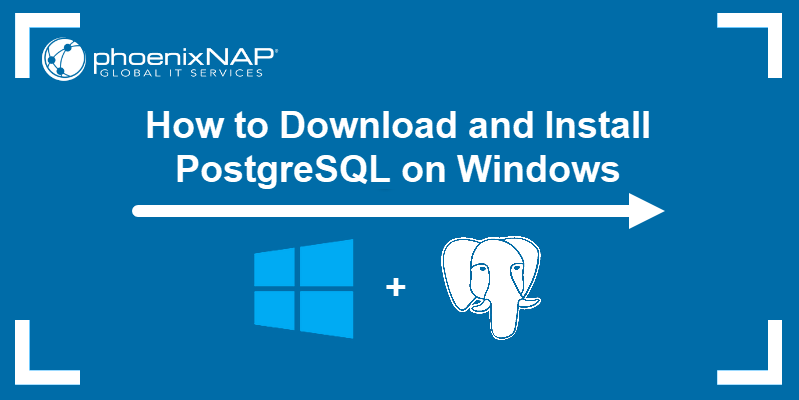
Prerequisites
- A system running Windows 10
- Access to a user account with administrator privileges
Download PostgreSQL Installer
Before installing PostgreSQL, you need to download the installation file from the EDB website.
Find the Windows x86-64 category for the latest version of PostgreSQL and click the Download button.
Follow the steps below to install PostgreSQL on Windows:
1. Open the PostgreSQL install file to start the installation wizard. Click Next to continue.
2. Choose an install location for PostgreSQL and click Next to proceed.
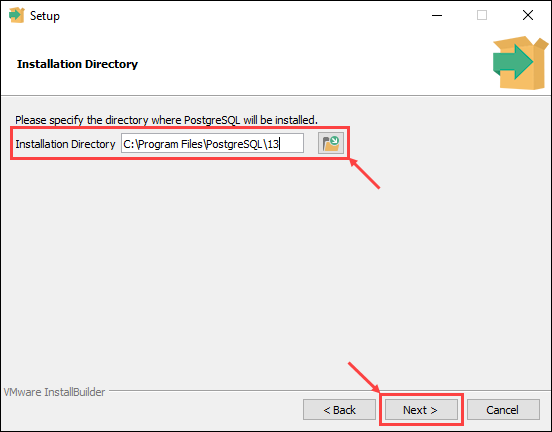
3. Select which software components you want to install:
- PostgreSQL Server: Installs the PostgreSQL database server.
- pgAdmin 4: Provides a graphical interface for managing PostgreSQL databases.
- Stack Builder: Allows you to download and install additional tools to use with PostgreSQL.
- Command Line Tools: Installs the command line tool and client libraries. Required when installing PostgreSQL Server or pgAdmin 4.
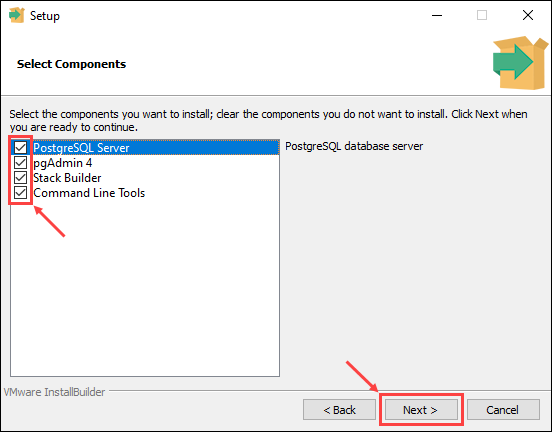
Once you check the boxes next to the components you want to install, click Next to continue.
4. Choose a database directory to store data and click Next to continue.
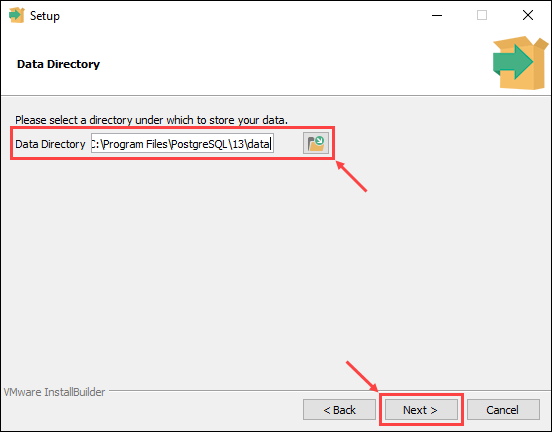
5. Enter and retype the password for the database superuser. Click Next to proceed.
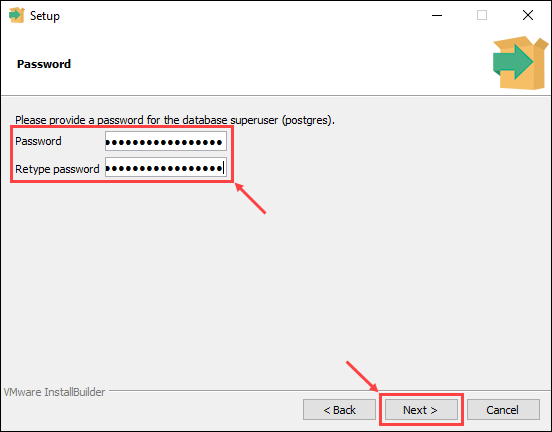
Note: PostgreSQL runs as a background process under a service called postgres. If you already have a service named postgres running, enter the password for that service account when prompted.
6. Enter the port number for the PostgreSQL server to listen on and click Next to continue.
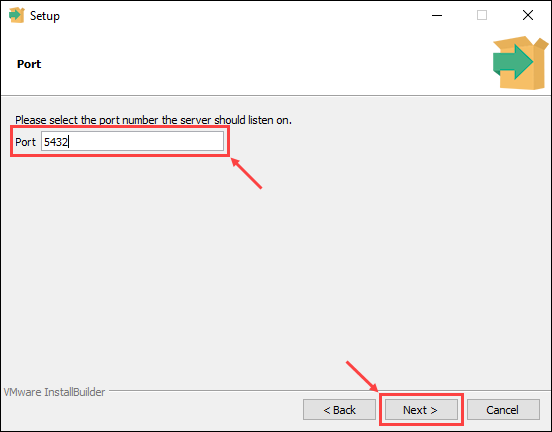
Note: The default port number for the PostgreSQL server is 5432. When entering a custom port number, make sure no other applications are using the port.
7. Choose the locale for the database to use. Selecting the [Default locale] option uses the locale settings for your operating system. Once you have chosen a locale, click Next to continue.
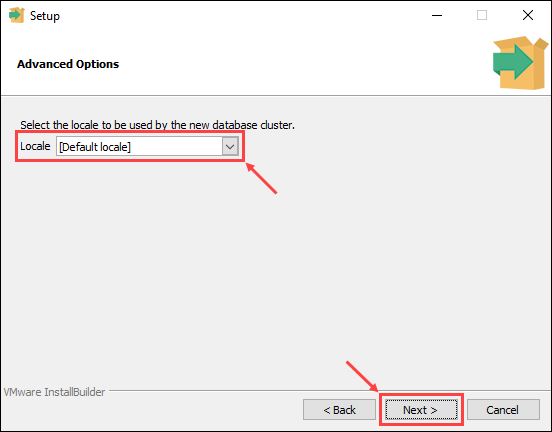
8. The last step offers a summary of the installation settings. Click Back if you want to change any of the settings you made, or click Next to proceed.
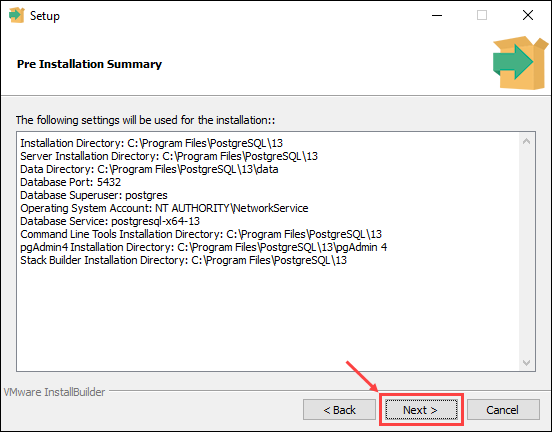
9. The setup wizard informs you it is ready to start the installation process. Click Next to begin installing PostgreSQL.
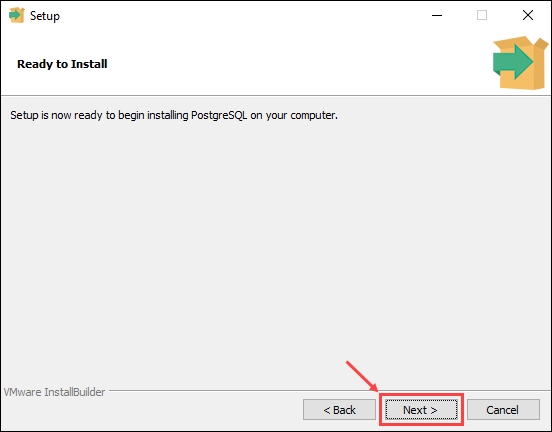
Connect to the PostgreSQL Database
You can verify the new PostgreSQL installation by connecting to the database using the SQL shell or the pgAdmin tool:
Connect to the PostgreSQL Database Using the SQL Shell (psql)
1. Open the SQL Shell (psql) in the PostgreSQL folder in the Start menu.
2. Enter the information for your database as defined during the setup process. Pressing Enter applies the default value, as shown in the square brackets.

3. Verify the new database by using the command:
select version();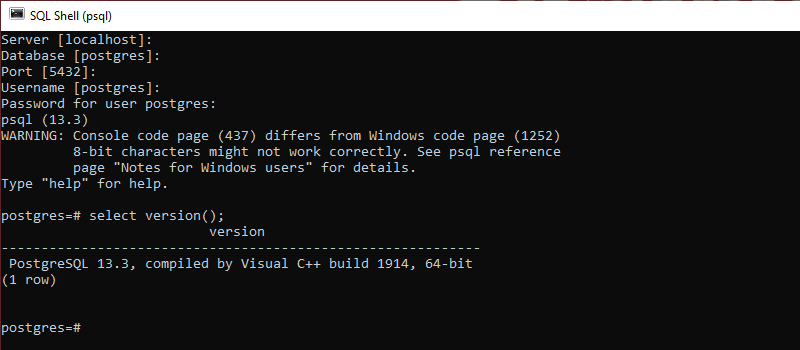
Connect to the PostgreSQL Database Using pgAdmin
1. Open the pgAdmin 4 tool from the PostgreSQL folder in the Start menu.
Note: pgAdmin requires you to set a master password at first launch.
2. Right-click the Servers icon on the left-hand side. Select Create > Server to set up a new database server.
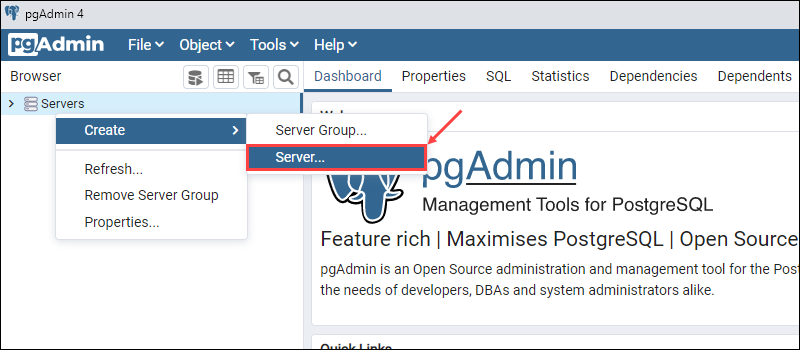
3. In the General tab, enter the name for the new database. In this example, we are using PostgreSQL as the database name.
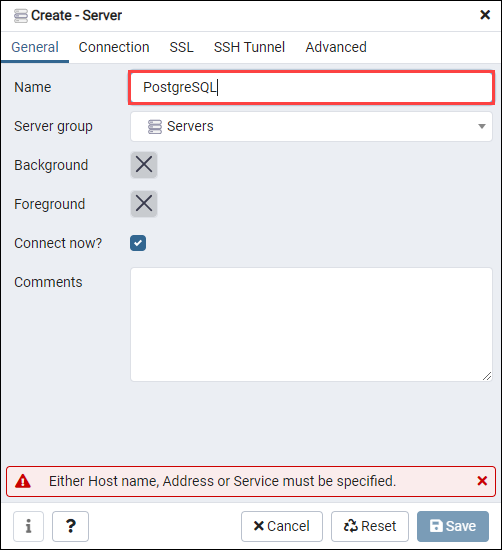
4. In the Connection tab, enter the hostname (default is localhost) and password selected during the setup process. Click Save to create the new database.
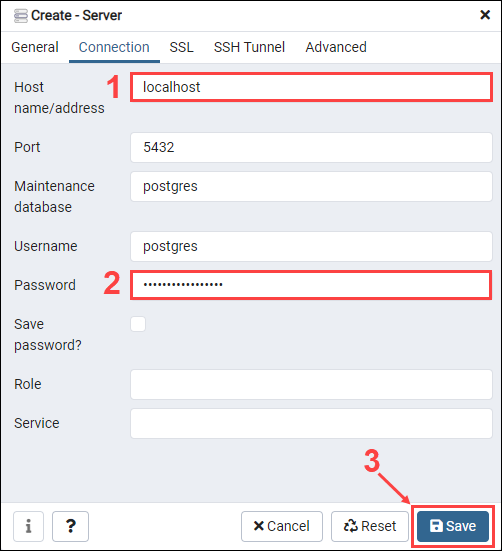
5. Expand the server display by clicking on the Servers > PostgreSQL icons on the left-hand side. Select the default postgres database.
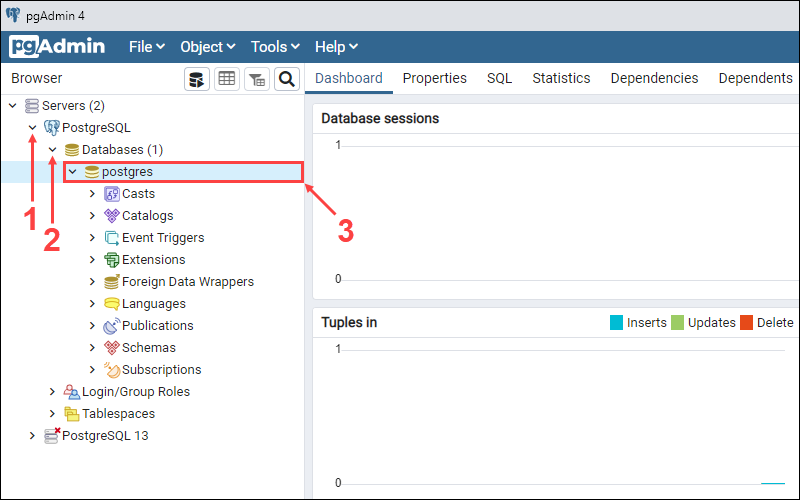
6. In the Tools drop-down menu, click Query Tool to open the query editor.
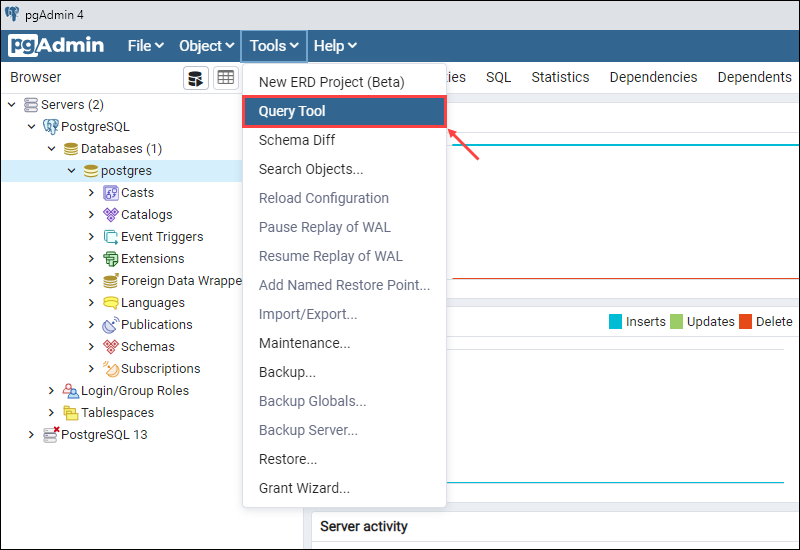
7. Verify the database in the query editor by entering the following command and clicking the Execute button:
select version();If the database is working properly, the current version of the database will appear in the Data Output section.
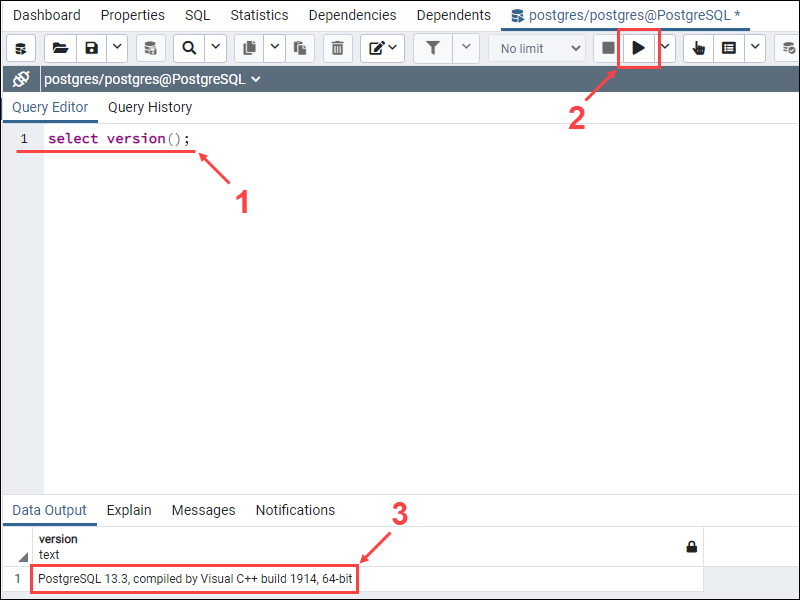
Conclusion
After following this tutorial, you should have PostgreSQL installed and working on your Windows system. You should also have your first PostgreSQL database set up and ready to use.
Данная статья относится к циклу статей, посвященных PostgreSQL. В предыдущей статье мы узнали о PostgreSQL
и функциях, которые выделяют PostgreSQL среди других систем управления базами данных. Теперь мы покажем вам, как установить
PostgreSQL для изучения и практики в вашей локальной системе.
PostgreSQL был разработан для UNIX-подобных платформ, однако он также был разработан переносным. Это означает, что
PostgreSQL может работать и на других платформах, таких как Mac OS X, Solaris и Windows.
Начиная с версии 8.0, PostgreSQL предлагает установщик для операционных систем Windows, который делает процесс установки
простым и быстрым. В целях разработки мы установим PostgreSQL версии 11.3 на Windows 10.
Необходимо пройти три этапа для того, чтобы установить PostgreSQL:
- Загрузить установщик PostgreSQL для Windows
- Установить PostgreSQL
- Убедиться в правильной установке
Загрузка установщика PostgreSQL для Windows
В первую очередь, вам нужно перейти на страницу загрузки PostgreSQL на EnterpriseDB.
Затем, нажать на ссылку для скачивания, как показано ниже:
Загрузка установщика займет всего несколько минут.
Шаг 1. Дважды щелкните по исполняемому файлу, появится мастер установки, где вы сможете выбрать различные параметры,
которые вы хотели бы видеть в PostgreSQL.
Шаг 2. Нажмите кнопку Next
Шаг 3. Укажите папку для установки, выберите свою собственную или оставьте папку по умолчанию, предложенную установщиком
PostgreSQL, и нажмите кнопку Next.
Шаг 4. Выберите компоненты для установки и нажмите кнопку Next
Шаг 5. Выберите каталог базы данных для хранения информации. Оставьте его по умолчанию или выберите свой и нажмите Next.
Шаг 6. Введите пароль для суперпользователя базы данных (postgres)
Шаг 7. Введите порт для PostgreSQL. Убедитесь, что никакие другие приложения не используют этот порт. Оставьте его
по умолчанию, если вы не уверены.
Шаг 8. Выберите язык по умолчанию, используемый базой данных, и нажмите Next.
Шаг 9. PostgreSQL готов к установке. Нажмите кнопку Next, чтобы начать установку.
Установка может занять несколько минут.
Шаг 10. Нажмите кнопку Finish, чтобы завершить установку PostgreSQL.
Проверка установки
Есть несколько способов проверки установки. Вы можете попытаться подключиться к серверу базы данных PostgreSQL из любого
клиентского приложения, например: psql и phAdmin.
Быстрее всего проверить установку можно через программу psql.
Сначала нажмите на значок psql, чтобы запустить его. Откроется командная строка окна psql.
Затем, введите всю необходимую информацию, такую как сервер, база данных, порт, имя пользователя и пароль. Чтобы принять
значение по умолчанию, нажмите Enter. Обратите внимание, что вы должны предоставить пароль, который вы ввели
при установке PostgreSQL.
Затем, введите команду SELECT version(); вы увидите следующий результат:
Поздравляем! Вы успешно установили сервер базы данных PostgreSQL в своей локальной системе. В следующей статье мы изучим
различные способы подключения к серверу баз данных PostgreSQL.
Источник: PostgreSQL Tutorial from Scratch
Improve Article
Save Article
Improve Article
Save Article
This is a step-by-step guide to install PostgreSQL on a windows machine. Since PostgreSQL version 8.0, a window installer is available to make the installation process fairly easier.
We will be installing PostgreSQL version 11.3 on Windows 10 in this article.
There are three crucial steps for the installation of PostgreSQL as follows:
- Download PostgreSQL installer for Windows
- Install PostgreSQL
- Verify the installation
Downloading PostgreSQL Installer for Windows
You can download the latest stable PostgreSQL Installer specific to your Windows by clicking here
Installing the PostgreSQL installer
After downloading the installer double click on it and follow the below steps:
- Step 1: Click the Next button
- Step 2: Choose the installation folder, where you want PostgreSQL to be installed, and click on Next.
- Step 3: Select the components as per your requirement to install and click the Next button.
- Step 4: Select the database directory where you want to store the data an click on Next.
- Step 5: Set the password for the database superuser (Postgres)
- Step 6: Set the port for PostgreSQL. Make sure that no other applications are using this port. If unsure leave it to its default (5432) and click on Next.
- Step 7: Choose the default locale used by the database and click the Next button.
- Step 8: Click the Next button to start the installation.
- Wait for the installation to complete, it might take a few minutes.
- Step 9: Click the Finish button to complete the PostgreSQL installation.
Verifying the Installation of PostgreSQL
There are couple of ways to verify the installation of PostgreSQL like connecting to the database server using some client applications like pgAdmin or psql.
The quickest way though is to use the psql shell. For that follow the below steps:
- Step 1: Search for the psql shell in the windows search bar and open it.
- Step 2: Enter all the necessary information like the server, database, port, username, and
password and press Enter. - Step 3: Use the command SELECT version(); you will see the following result:
Improve Article
Save Article
Improve Article
Save Article
This is a step-by-step guide to install PostgreSQL on a windows machine. Since PostgreSQL version 8.0, a window installer is available to make the installation process fairly easier.
We will be installing PostgreSQL version 11.3 on Windows 10 in this article.
There are three crucial steps for the installation of PostgreSQL as follows:
- Download PostgreSQL installer for Windows
- Install PostgreSQL
- Verify the installation
Downloading PostgreSQL Installer for Windows
You can download the latest stable PostgreSQL Installer specific to your Windows by clicking here
Installing the PostgreSQL installer
After downloading the installer double click on it and follow the below steps:
- Step 1: Click the Next button
- Step 2: Choose the installation folder, where you want PostgreSQL to be installed, and click on Next.
- Step 3: Select the components as per your requirement to install and click the Next button.
- Step 4: Select the database directory where you want to store the data an click on Next.
- Step 5: Set the password for the database superuser (Postgres)
- Step 6: Set the port for PostgreSQL. Make sure that no other applications are using this port. If unsure leave it to its default (5432) and click on Next.
- Step 7: Choose the default locale used by the database and click the Next button.
- Step 8: Click the Next button to start the installation.
- Wait for the installation to complete, it might take a few minutes.
- Step 9: Click the Finish button to complete the PostgreSQL installation.
Verifying the Installation of PostgreSQL
There are couple of ways to verify the installation of PostgreSQL like connecting to the database server using some client applications like pgAdmin or psql.
The quickest way though is to use the psql shell. For that follow the below steps:
- Step 1: Search for the psql shell in the windows search bar and open it.
- Step 2: Enter all the necessary information like the server, database, port, username, and
password and press Enter. - Step 3: Use the command SELECT version(); you will see the following result:

